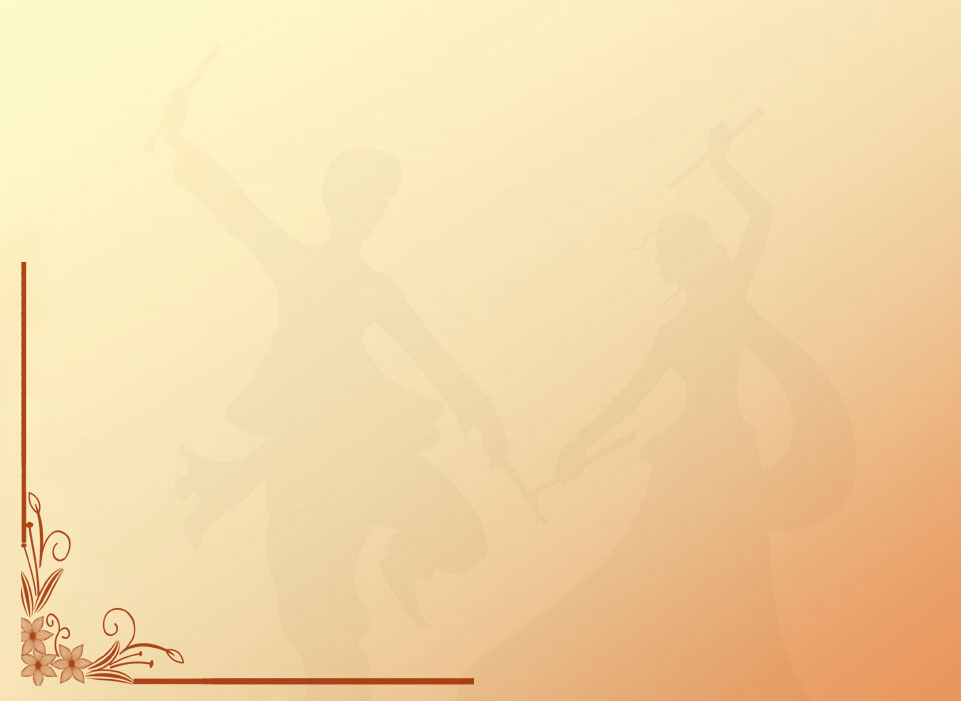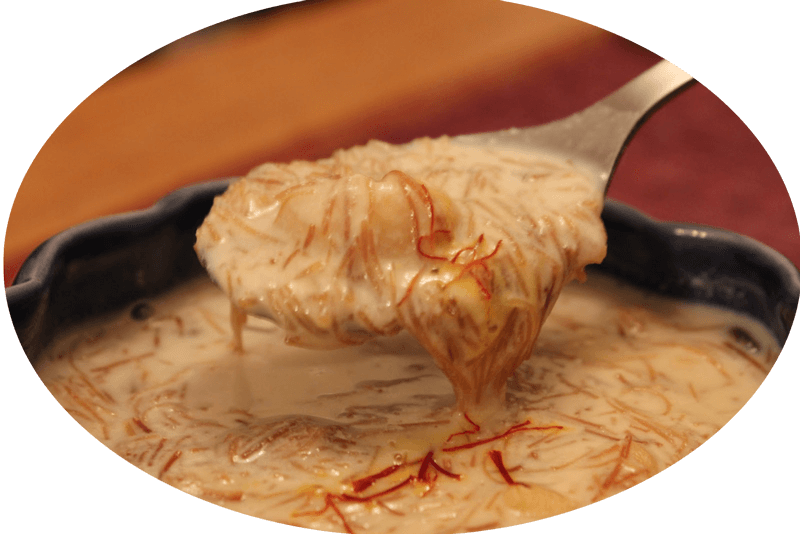
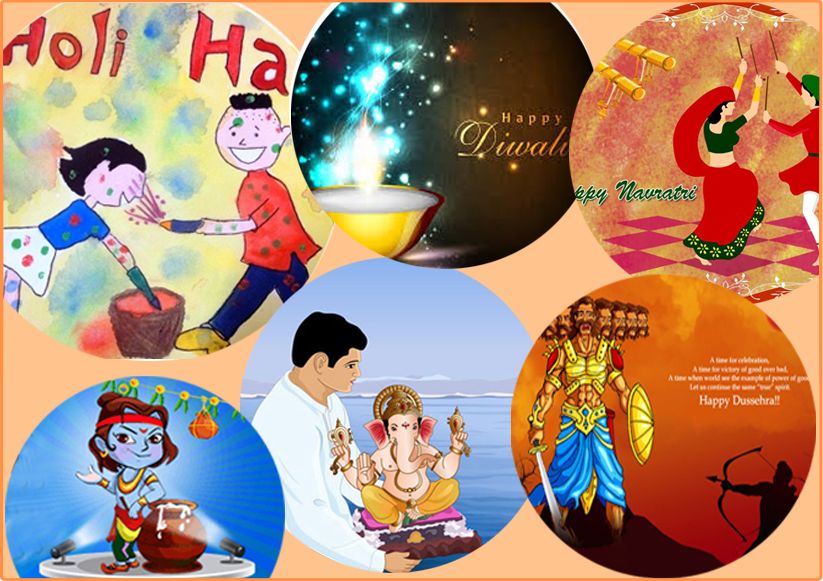
☬ Navratri & Dussera ☬
Dussera
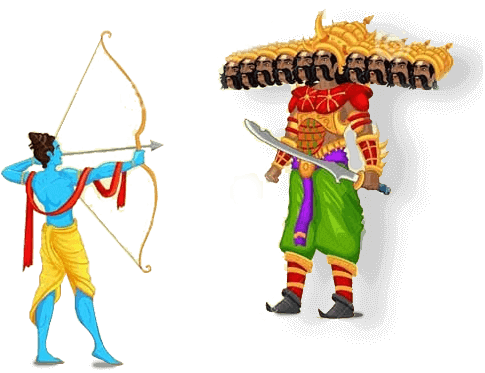 The festival of Dussehra, also known as Vijayadashmi, is one of the fascinating festivals of India and is celebrated with joy and enthusiasm.
The festival of Dussehra, also known as Vijayadashmi, is one of the fascinating festivals of India and is celebrated with joy and enthusiasm.According to the great Hindu scripture, the Ramayana, Lord Rama performed chandi-puja (holy prayer). This was carried out in order to invoke the blessings of Durga Maa for the killing of Ravana, the ten-headed demon king of Sri Lanka who had abducted Seeta, wife of Lord Rama.
Durga Maa divulged the secret to Rama as to how he could slay the great Ravana. Upon vanquishing the demon Ravana, Lord Rama with Sita and younger brother Laxmana, returned victorious to his kingdom of Ayodhya on the day which is called 'Diwali'. Revellers across northern India re-enact this legend at sundown in a performance called the Ramlila, featuring actors dressed as Rama shooting flaming arrows at effigies of Ravana stuffed with firecrackers.
Dussera day is considered a most auspicious day. It is a time-honored belief that if any new venture is started on this day, it is bound to be successful. Hence, all new undertakings, be it laying-in of the foundation of a new building, opening of a new commercial establishment or even initiating a child into the world of learning- are started on this day. Also on this day implements of agriculture, manufacturer's machines, the intellectuals' pens, the household articles, the children's school books are placed before the idol of Durga and worshipped.
Navratri
Navratri, the festival of nights, lasts for 9 days with three days each devoted to worship of Maa Durga, the Goddess of Valor, Maa Lakshmi, the Goddess of Wealth and Maa Saraswati, the Goddess of Knowledge.
During the nine days of Navratri, feasting and fasting take precedence over all normal daily activities amongst the Hindus. Evenings give rise to the religious dances in order to worhip Goddess Durga Maa.
1st-3rd Day of Navratri
 On the first day of the Navaratras, a small bed of mud is prepared in the puja room of the house and barley seeds are sown on it. On the tenth day, the shoots are about 3 - 5 inches in length. After the puja, these seedlings are pulled out and given to devotees as a blessing from god.
On the first day of the Navaratras, a small bed of mud is prepared in the puja room of the house and barley seeds are sown on it. On the tenth day, the shoots are about 3 - 5 inches in length. After the puja, these seedlings are pulled out and given to devotees as a blessing from god.These initial days are dedicated to Durga Maa, the Goddess of power and energy. Her various manifestations, Kumari, Parvati and Kali are all worshipped during these days. They represent the three different classes of womanhood that include the child, the young girl and the mature woman.
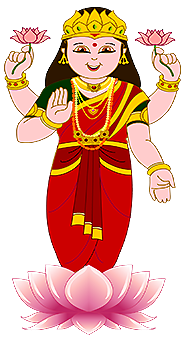
4th-6th day of Navratri
During these days, Lakshmi Maa, the Goddess of peace and prosperity is worshipped. On the fifth day which is known as Lalita Panchami, it is traditional to gather and display all study books and literature available in the house, and light a lamp or 'diya' to invoke Saraswati Maa, the Goddess of knowledge and art.7th -8th day of Navratri
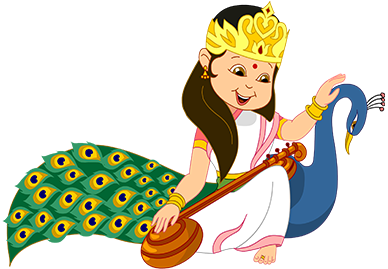 These final days belong to Saraswati Maa who is worshipped to acquire the spiritual knowledge. This in turn will free us from all earthly bondage. But on the 8th day of this colourful festival, yagna (holy fire) is performed. Ghee (clarified butter), kheer (rice pudding) and sesame seeds form the holy offerings to Goddess Durga Maa.
These final days belong to Saraswati Maa who is worshipped to acquire the spiritual knowledge. This in turn will free us from all earthly bondage. But on the 8th day of this colourful festival, yagna (holy fire) is performed. Ghee (clarified butter), kheer (rice pudding) and sesame seeds form the holy offerings to Goddess Durga Maa.Mahanavami
The festival of Navratri culminates in Mahanavami. On this day Kanya Puja is performed. Nine young girls representing the nine forms of Goddess Durga are worshipped. Their feet are washed as a mark of respect for the Goddess and then they are offered new clothes as gifts by the worshipper. This ritual is performed in most parts of the country.☬ Durga Aarti ☬
Jai ambe gaurii maiyaa, Jai shyaamaa gaurii Nishadina tumako dhyaavata, Hari brahma shivajii
"Glory to you, O divine Mother Gauri, glory to you,
O Parvati, who are so rich in maiden grace (virgin beauty), the object of daily meditation by Vishnu, Brahma and Shiva!"
Maanga sinduura viraajata, Tiko mriga madako Ujjvalase dauu nainaa, Chandravana niiko
"O Ambe! On your forehead is a resplendent mark of vermilion along with a mark of musk (signifying good luck). Your twin eyes are bright and your face beautiful as the moon."
Kanaka samaana kalevara, Raktaambara raaje Raktapushpa galamaalaa, Kanthahaara saaje
"Your body with a tinge of gold is splendidly dressed in red attire; on your throat lies a wreath of red blossoms like a beautiful necklace."
Kehari vaahana raajata, Khadaga khappara dhaari Sura nara munijana sevata, Tinake dukha haari
"Your vehicle, the lion, is, O Mother, in keeping with your splendid form; you bear a sword and a skull in your hands, and on you attend the gods, men, hermits and your votaries whose grief you drive away."
Kaanana kunadala shobhita, Naasaagre motii Kotika chandra divaakara, Sam raajata jyotii
"You are adorned with rings on your ears and with pearl on the tip of your nose, your radiance looks as splendid as that of a myriad suns and moons."
Shumbha nishumbha bidaare, Mahishaasura ghaatii Dhuumra vilochana nainaa, Nishadina madamaatii
"O slayer of the demon Mahisha, you tore apart the bodies of Shumbha, Nishumbha and Dhuumravilochana. (In the battle waged against them) your eyes reflected a frenzy of fury everyday and night."
Brahmaanii rudraanii, Tuma kamalaa raanii Aagama-nigama bakhaanii, Tuma shiva pataraanii
"You are the beloved consort of Brahma, Rudra and Vishnu. The Vedas and the Shastras describe you as the queen consort of Shiva,"
Chausatha yoginii gaavata, Nritya karata bhairon Baajata taala mridanga, Aura baajata damaruu
"Sixty-four Yoginis chorus your praise and glorify you, while Bhairava (Shiva) dances in tune to the accompaniment of the sound of tambour (mridanga) and drum (damaru)."
Tuma ho jaga kii maataa, Tuma hii ho bhartaa Bhaktana kii dukha hartaa, Sukha sampati kartaa
"You are mother of the universe, its sustainer, reliever of your devotees' affliction and bestower of happiness and prosperity."
Bhujaa chaara ati shobhita, Vara mudraa dhaarii Manavaanchita phala paavata, Sevata nara naarii
"The four arms you have adorned your person, while the hand raised in benediction reveals your benign aspect. Those among men and women who wait on you and worship you have all their cherished wishes ever fulfilled."
Kanchana thaala viraajata, Agaru kapuura baatii Bhaalaketu mein raajata, Kotiratana jyotii
"In a golden platter are beautifully laid aloe and camphor, both of which have lighted (to be waved before you); in he radiance of your forehead is reflected the splendour of a myriad gems."
☬ Recipe - Sutto ☬
Ingredients
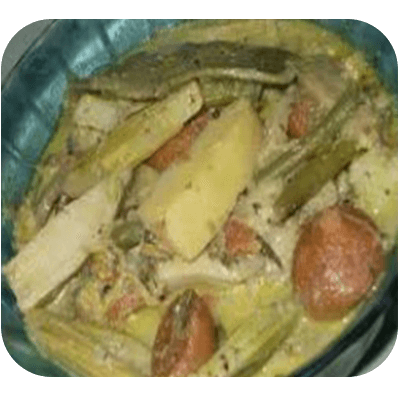 Potato, Ghee, Sugar, Ginger paste, Radhuni (a species of celery seeds), Dried red chili ,Mustard paste, Green banana, Bitter gourd , Brinjal, Beans,Sun dried small pulse cakes,Oil ,Salt ,Turmeric,Milk , Coconut paste, Cumin powder , Kismis , Ghee, Refined flour (maida).
Potato, Ghee, Sugar, Ginger paste, Radhuni (a species of celery seeds), Dried red chili ,Mustard paste, Green banana, Bitter gourd , Brinjal, Beans,Sun dried small pulse cakes,Oil ,Salt ,Turmeric,Milk , Coconut paste, Cumin powder , Kismis , Ghee, Refined flour (maida).
Method
Dice the vegetables finely and then fry in oil. Cover the vegetables with salt and turmeric powder and place in a wok to cook. Add mustard seeds and panch phoron and red chilies. Continue stirring. Add coconut paste, ginger paste, and mustard paste along with radhuni, salt and sugar. Cook for sometime and remove from heat. When cooled add a small amount of milk flour and ghee. Before serving, spread panch phoron, cumin and radhuni powder over the preparation.☀ Diwali - Festival of Light ☀
Diwali is a five day Hindu festival which occurs on the fifteenth day of Kartika. During this time, homes are thoroughly cleaned and windows are opened to welcome Laksmi, goddess of wealth. Candles and lamps are lit as a greeting to Laksmi. Gifts are exchanged and festive meals are prepared during Diwali. Diwali, being the festival of lights, thousands of lamps are lit in and outside every home on the day. Lamp or “Deep” is the symbol of knowledge. Lighting the lamp of knowledge within us means to understand and reflect upon the significant purpose of each of the five days of festivities and to bring those thoughts in to our day to day lives.
The celebration of the festival is customarily accompanied by the exchange of sweets and the explosion of fireworks. Diwali is an occasion for cheerfulness and togetherness. This is an occasion for young and the old, men and women, rich and poor - for everyone to celebrate. Irrespective of their religious and economic background, the festival is celebrated throughout the country to ward off the darkness and welcome light into life as light is always associated with hope for the future Diwali is celebrated 20 days after Dussera every year.
Of all the festivals celebrated in India, Diwali is by far the most glamorous and important. Enthusiastically enjoyed by people of every religion, its magical and radiant touch creates an atmosphere of joy and festivity. Diwali Celebrations in India are similar to Christmas celebrations in the USA. It is also marked as the beginning of the Hindu New Year and as a brand new beginning for all. Diwali is celebrated for five days, each day having it's own significance, rituals and myths.
☀ Diwali - The message behind ☀
According to the Vedic culture, the message of Tamaso ma jyotir gamaya (from darkness unto light) is given through the festival of Deepawali to all the people in the world. During the night of Deepawali myriads of little clay lamps (diyas) seem to silently send forth Deepawali messages: Come let us remove darkness from the face of the earth. This is not the work to be done by one diya or by one individual. It requires collective effort. In the diffusion of light the question of high and low is forgotten. This is the lesson taught by both small and big diyas.
The second message of the burning diyas is to destroy the difference between rich and poor- the destruction of discrimination based on poverty and wealth. The burning diya, whether in a palatial bungalow or in a grass hut, is a symbol of this unity. The wall of separation based on economic status cannot prevent the penetration and spread of the light of the diya. The third message of the burning diyas of Deepawali is to kindle the extinguished lights of our neighbours. Let us find out what is needed- whether there is a shortage of wick or oil- and with just a little help the neighbour’s lamps can be lit. One diya can light several others. A little charity can bring joy to countless others.
The row of lamps teach yet another lesson and that is of unity as exemplified in Satyam, Shivam Sundaram- Truth, Joy and Beauty.
The lights of Deepavali are displayed at the entrance doors, by the walls of houses, in the streets and lanes. This means that the inner spiritual light of the individual must be reflected outside. Passersby may thereby be prevented from stumbling or straying on their way to their destinations.
The lights of the diyas on earth beckon to the lights in the firmament to descend upon earth and establish the heavenly kingdom of God for the welfare of the human race.
Feeding empty stomachs, lighting unlit diyas and spreading cheer and joy amongst the downtrodden is the way to enter into the true spirit of Deepavali. This is the true prayer to Lakshmi Devi.
☀ The Mythological Reference ☀
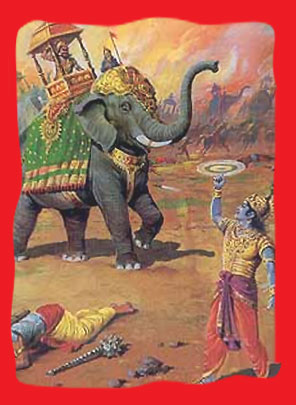 According to Ramayana, Diwali commemorates the return of Ram, an incarnation of Lord Vishnu and the eldest son of King Dasharath of Ayodhya, from his 14-year exile with Sita and Lakshman after killing the Ravan, a demon king. The people of Ayodhya illuminated the kingdom with earthen diyas (oil lamps) and fireworks to celebration of the return of their king.
According to Ramayana, Diwali commemorates the return of Ram, an incarnation of Lord Vishnu and the eldest son of King Dasharath of Ayodhya, from his 14-year exile with Sita and Lakshman after killing the Ravan, a demon king. The people of Ayodhya illuminated the kingdom with earthen diyas (oil lamps) and fireworks to celebration of the return of their king.In rural areas, Diwali signifies Harvest Festival. Diwali which occurs at the end of the cropping season has along with the above custom, a few others that strengthen the belief of its having originated as a harvest festival. Every harvest normally spelt prosperity. The celebration was first started in India by farmers after they reaped their harvests. They celebrated with joy and offered praises to God for granting them a good crop.
During the reign of Emperor Prithu, there was a worldwide famine. He ordered that all available cultivable lands be ploughed. When the rains came, the land became very fertile and seeds were sown. The harvest provided food not only to feed all of India, but for all civilisation. This harvest was close to Diwali time and was a good reason to celebrate Diwali with great joy and merriment by a wider community.
When Lord Krishna destroyed Narakasur on the day before Diwali, the news travelled very rapidly throughout the land. It gave people who were already in a joyful mood, another reason for celebrating Diwali with greater pride and fanfare.
In the Adi Parva of the Mahabarata, the Pandavas returned from the forest during Diwali time. Once more, the celebrations extended beyond the boundaries of India to wherever Hindus lived.
It is on the same day of Amavasya that Swami Dayananda Saraswati, that leonine sanyasin who was one of the first to light the torch of Hindu Renaissance during the last century, passed into Eternity. Swami Ramatirtha who carried the fragrance of the spiritual message of Hindu Dharma to the western world, also passed into Eternity. The lights kindled on this day also mark the attempt of their followers to immortalize the sacred memories of those great men who lived to brighten the lives of millions of their fellow beings. The passage of these great men have indeed brought the national-cum-spiritual tradition of Deepavali right up to, and relevant to modern times.
☀ The Celebrations ☀



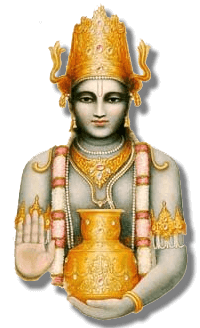 Diwali is celebrated for five days, each day having its own significance, rituals and beliefs.
Diwali is celebrated for five days, each day having its own significance, rituals and beliefs.The First Day Of Diwali
The first day of Diwali is called Dhanvantari Triodasi or Dhanwantari Triodasi, also called Dhan Theras. It is in fact the thirteenth lunar day of Krishna Paksh (the dark fortnight) of the month of Kartik. On this day, Lord Dhanwantari came out of the ocean with Ayurvedic medicines (medicine which promotes healthy long life) for mankind.The Second Day Of Diwali
The second day of Diwali is called Narak Chaturdasi. It is the fourteenth lunar day (thithi) of the dark fortnight of the month of Kartik and the eve of Diwali. On this day Lord Krishna destroyed the demon Narakasur and made the world free from fear. On this day, we should massage our bodies with oil to relieve it of tiredness, bathe and rest so that we can celebrate Diwali with vigour and devotion.This day marks the beginning of Diwali celebrations. On this day at sunset, Hindus should bathe and offer a lighted deeya with Prasad (sweets offered at worship time) to Yama Raj (the Lord of Death) and pray for protection from untimely death.
This offering should be made near a Tulsi tree (the Holy Basil) or any other sacred tree that one might have in their yard. If there is no sacred tree, a clean place in the front yard will suffice.
On this night, Yama Deeya should NOT be lit. The Shastras (Laws of Dharma) declares that Yama Deeya should be offered on Triodasi night with Prasad.
The misconception that Yama Deeya should be offered on the night before Diwali came about some years ago when the fourteenth lunar day (Chaturdasi) was of a very short duration and caused Triodasi to extend into the night before Diwali. Some people mistook it to mean that because Yama Deeya was lit on that night, that it should always be lit on the night before Diwali.
This is absolutely not true. It is advisable that one consults a learned Pandit or Hindu Astrologer for proper guidance in this matter.
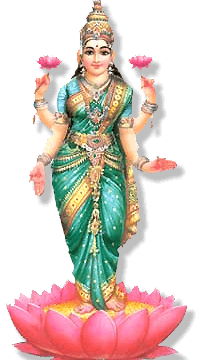
The Third Day Of Diwali
This is the day when worship unto Mother Lakshmi is performed. Hindus cleanse themselves and join with their families and their Pandit (priest) and worship the divine Goddess Lakshmi to achieve the blessings of wealth and prosperity, to commemorate the triumph of good over evil and light over darkness.The Fourth Day Of Diwali
On this day, Govardhan Pooja is performed. Many thousands of years ago, Lord Krishna caused the people of Vraja to perform Govardhan Pooja. From then on, every year Hindus worship Govardhan to honour that first Pooja done by the people of Vraja.It is written in the Ramayan that when the bridge was being built by the Vanar army, Hanuman (a divine loyal servant of Lord Rama possessing enormous strength) was bringing a mountain as material to help with the construction of the bridge. The call was given that enough material was already obtained. Hanuman placed the mountain down before He could reach the construction site. Due to lack of time, He could not have returned the mountain to its original place.
The deity presiding over this mountain spoke to Hanuman asking His reason for leaving the mountain there. Hanuman replied that the mountain should remain there until the age of Dwapar when Lord Rama incarnates as Lord Krishna in the form of man. He, Lord Krishna will shower His grace on the mountain and will instruct that the mountain be worshiped not only in that age but but in ages to come. This deity whom Hanuman spoke to was none other than Govardhan (an incarnation of Lord Krishna),who manifested Himself in the form of the mountain.
To fulfill this decree, Govardhan Pooja was performed and is continued to be performed today.
The Fifth Day Of Diwali
The fifth day of the diwali is called Bhratri Dooja (Bhai-dooj). This is the day after Govardhan Pooja is performed and normally two days after Diwali day.It is a day dedicated to sisters. We have heard about Raksha Bandhan (brothers day). Well this is sisters day.
Many moons ago, in the Vedic era, Yama (Yamraj, the Lord of death) visited His sister Yamuna on this day. He gave his sister a Vardhan (a boon) that whosoever visits her on this day shall be liberated from all sins. They will achieve Moksha or final emancipation. From then on, brothers visit their sisters on this day to enquire of their welfare. This day marks the end of the five days of Diwali celebrations.
This is also known as Bhai fota among Bengalis. Bhai fota is an event especially among Bengalis when the sister prays for her brother's safety, success and well being.



☀ Diwali Sweets Recipe ☀
Badam Halwa Recipe
Ingredients:
• 1 Cup almonds
• 2-1/2 Cups sugar
• 2 Cups ghee
• 1 Pinch kesari
How to make Badam Halwa:
• Soak almonds in a bowl with boiling water.• Remove the skin of almonds and make fine paste by grinding them in a grinder. Boil sugar with one cup of water in a pan. Boil till it turns into syrup.
• Add almond paste to the boiling syrup and mix it well.
• Make a solution of kesari powder in little water and add to the syrup.
• Instantly mix one-cup ghee.
• As the above mixture turns paste-like, pour the remaining ghee gradually.
• A batter like mixture will be formed after sometime. Now remove it from the flame.
• Badam Halwa is ready to serve.
Besan Laddoo Recipe
Ingredients:
• 3/4 Cup besan• 3/4 Cup powdered sugar
• 1/3 Cup ghee
• 1/4 tsp Elaichi powder
• 2-3 Drops saffron colour
How to make Besan Laddoo:
• Mix the sugar and saffron colour together. Leave it aside.
• Melt ghee in a kadhai and cook the besan over low flame.
• Stir continuously till the besan becomes light brown in colour.
• Mix the elaichi powder and again stir.
• Remove from the flame and pour it on a thali. Let it cool.
• Now mix together the gram flour mixture and sugar.
• Divide it into equal parts and give the shape of laddus.
• Besan Laddoo is ready.
Gulab Jamun Recipe
Ingredients:
• 1 Cup heaped flour
• 2 Pinch soda powder
• 3 Cups Sugar
• 3 Cups Water
• 100 gms Ghee
• 3/4 Litre milk
• 6 Crushed cardamom
• 1 tbsp Sugar
• 1 tsp Rose essence
• 2 Pinch saffron
How to make Gulab Jamun:
• Boil the milk till it reduces to half cup.
• Cool and add soda powder and 1tbsp sugar.
• Mix properly and make it smooth.
• Slowly add flour and prepare a fine dough. Leave it for an hour.
• Apply little ghee on the your palms.
• Make small balls from the prepared mixture.
• Pour ghee in a pan and heat. Fry the balls in ghee on a low flame.
• Boil 3 cups of water with equal amout of sugar. Also add cardamom and saffron.
• Filter and add rose essence to it.
• Put the fried balls in this solution.
• Remove after 3-4 hours.
• Your gulab jamuns are ready to serve.
Pista Burfi Recipe
Ingredients:
• 400 gms Pistachios(kernels removed)
• 250 gms Sugar
• Water as required for sugar syrup
• 7-8 Leaves edible silver foil
How to make Pista Burfi:
• Blanch the pistacioas in boling water.
• Drain the water and remove peels.
• Make a dry paste of the blanced and peeled Pistachios without using water.
• Prepare sugar syrup
• Mix the pistachio paste with the syrup and
• Keep on stirring until it becomes solid
• Now spread out the silver foil and cut it into square pieces.
• Your Pista Burfi is ready.
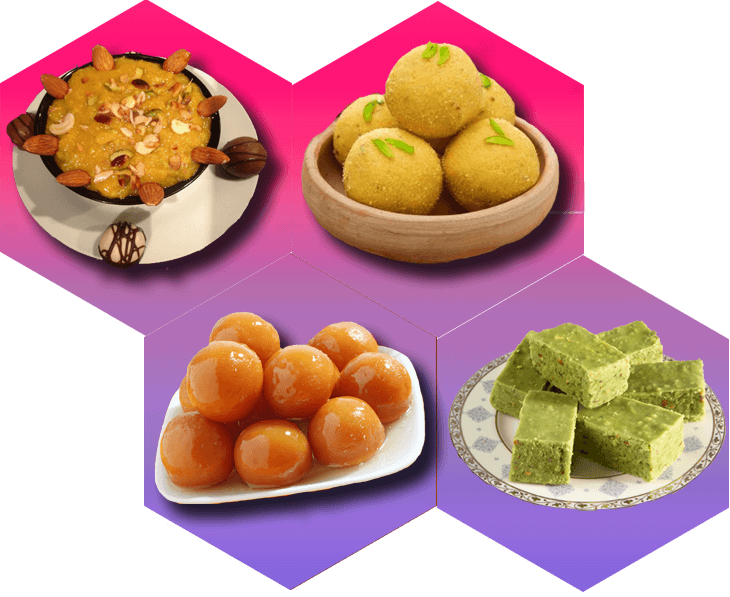
⚛ Onam - The Preparation ⚛
The festival is supposed to begin from the lunar asterism Atham which falls ten days before the asterism Thiruvonam. The preparations for the celebration begin on the Atham day. The Thiruvonam is the most important day of the festival. In the front yard of the house Athapoovu (floral decoration) is made for ten days from Atham to Thiruvonam. The idol of Thrikkakkara Appan made of clay is placed in the middle of the floral decoration.On the Thiruvonam day every one bathes and offers worship in temples early in the morning. Presents are distributed to the younger members of the family. Then follows the onam feast of delicious food served on plantain leaves. Members of families staying far away from their native place make it a point to visit their ancestral homes to celebrate the festival in the company of their kith and kin. Keralites celebrate Onam by organising community feasts, cultural programmes, etc.
After the feast there will be sports and games, both indoor and outdoor in which both men and women of all ages participate. Mock fights, ball games, card and chess are the favorites of the menfolk whereas women find pleasure in Oonjalattom, Thumbithullal, Thiruvathirakalim, Kaikottikali, etc.
Boat races (regattae) also form another facet of Onam festival which attracts thousands of people including tourists from outside the state.
Onam is celebrated by everyone in the state. Difference of caste and religion does not come in the way of the malayalees when they celebrate this spectacular festival.
⚛ The Celebration ⚛
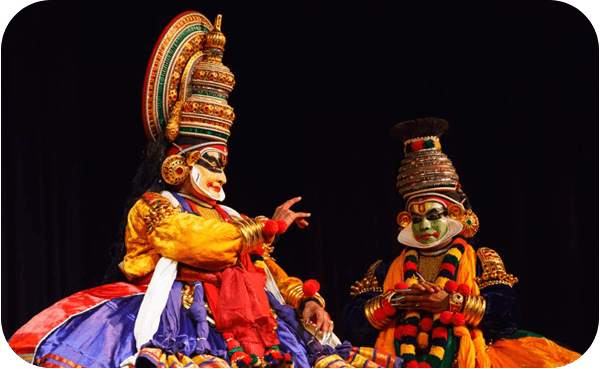 Onam basically celebrates the mythical king Mahabali, his golden rule and his sacrifice. It welcomes the spirit of King Mahabali and assures him that his people are happy and wish him well. Ten days of feasting, boat races, songs and dance are part of the festivities. Earthen mounds, which look like square pyramids, representing Mahabali and Vishnu are also placed in the dung-plastered courtyards.
Onam basically celebrates the mythical king Mahabali, his golden rule and his sacrifice. It welcomes the spirit of King Mahabali and assures him that his people are happy and wish him well. Ten days of feasting, boat races, songs and dance are part of the festivities. Earthen mounds, which look like square pyramids, representing Mahabali and Vishnu are also placed in the dung-plastered courtyards.After traditional prayers and worship, the head of the household presents new clothes to his family and friends. On Onam, everyone in the family would be wearing new clothes. Delicious sweetmeats and tongue-tickling vegetarian dishes would be cooked and served on banana leaves.
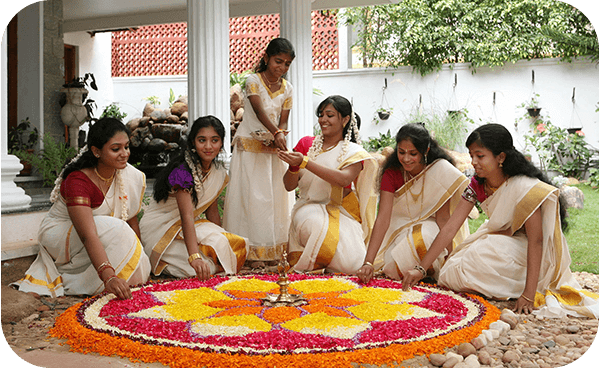 The Onam Festival is celebrated with Flower Decorations(Athappookkalam). Every year, women and children decorate the floor with floral designs. This starts from ten days before the feast. This flower decoration is like a symbol welcoming the King Mahabali. Flowers are used as national and religious symbols and to convey human sentiments.
The Onam Festival is celebrated with Flower Decorations(Athappookkalam). Every year, women and children decorate the floor with floral designs. This starts from ten days before the feast. This flower decoration is like a symbol welcoming the King Mahabali. Flowers are used as national and religious symbols and to convey human sentiments.

Pulikali, also known as Kaduvakali is a common sight during Onam season. Performers painted like tigers in bright yellow, red and black, dance to the beats of instruments like udukku and thakil.
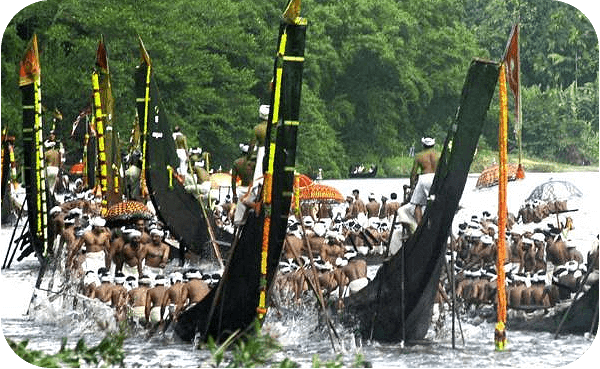
The Vallamkali (boat race) is one of the main attractions of Onam, and is best seen at Aranmulai and Kottayam. About a hundred oarsmen row huge and graceful odee (boats). Oars dip and flash to the rhythm of drums and cymbals in each boat.
Onam is celebrated by everyone alike in the state. Difference of caste and religion does not come in the way of Keralites when they celebrate this spectacular festival.
⚛ Floral Designs of Onam ⚛
These are a few flower decorations done during Onam. Move your mouse over to see bigger images of these decoration.
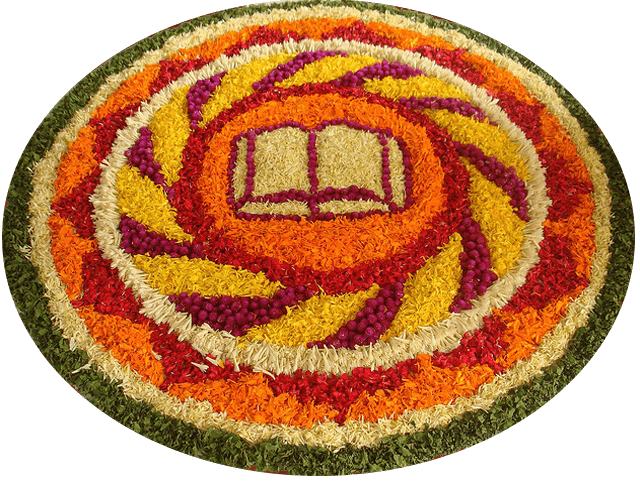
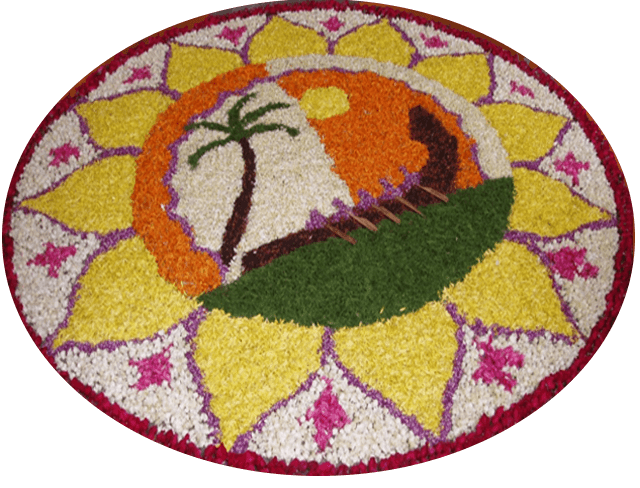
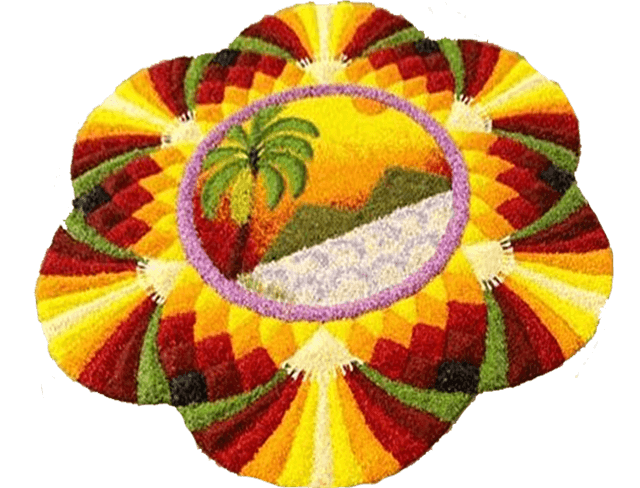
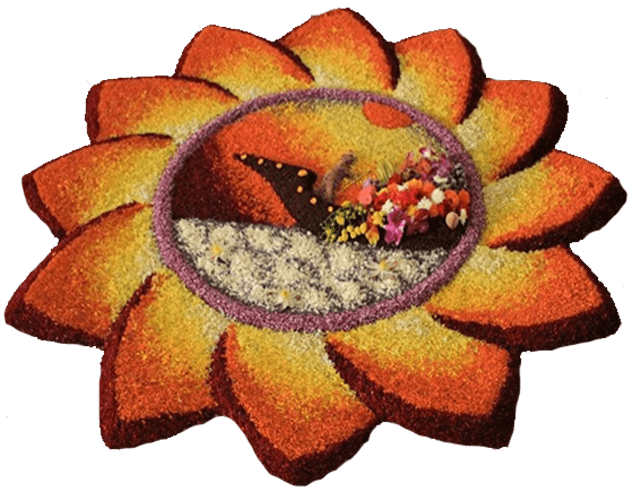

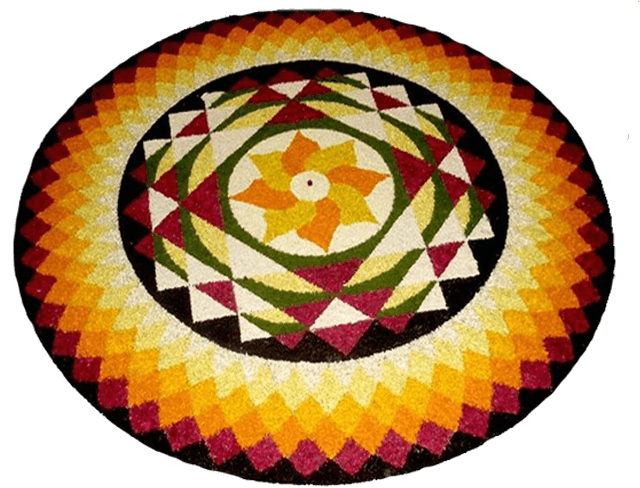

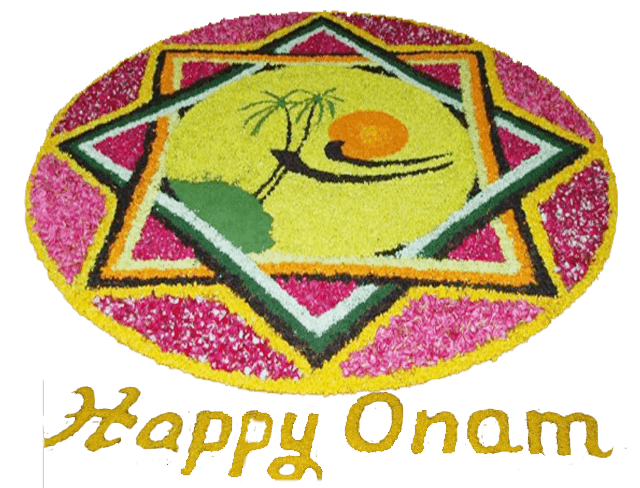
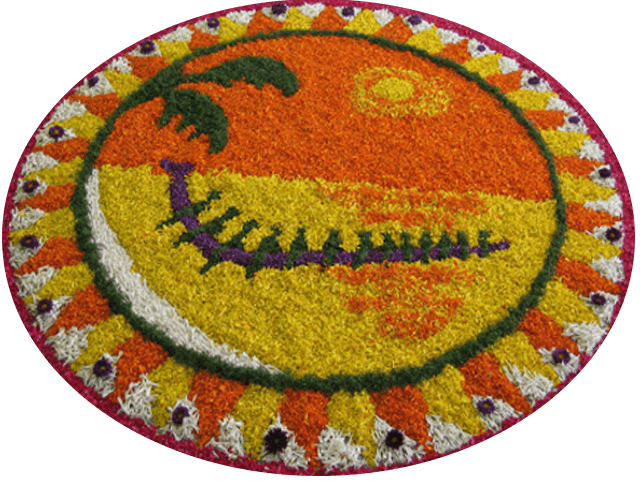
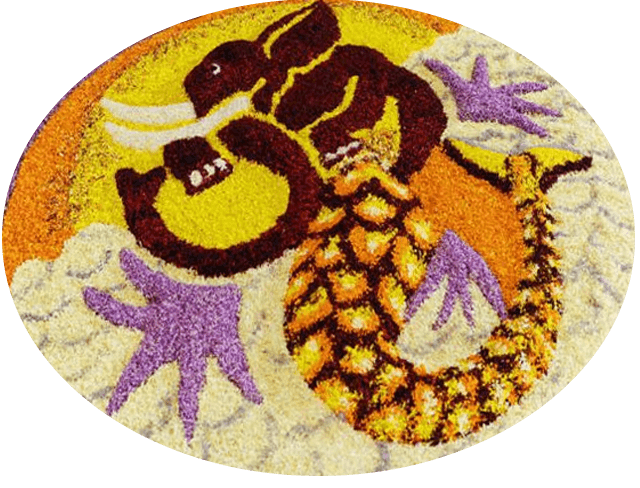
⚛ Onam Feast & Recipe ⚛
The sumptuous feast
 One of the many interesting things about Onam is 'Ona Sadya' (Onam Feast) having at least 11 dishes, maybe going up to 13 courses! The feast must be served on tender banana leaves. Then serve 'Pappad' on the extreme left and place a banana on top of the big 'papad'. The banana can be 'Rasakadali','Poovan' or 'Palayankodan'. From the right of papad onwards, serve salt, banana wafers, sarkarapuratti' fries after which ginger lime and mango pickles should be served. Next comes 'vellarika', 'pavakka' beetroot and 'ullikitchadi'. 'Kitchadi' made of pineapple and banana splits or of grapes & apple.
One of the many interesting things about Onam is 'Ona Sadya' (Onam Feast) having at least 11 dishes, maybe going up to 13 courses! The feast must be served on tender banana leaves. Then serve 'Pappad' on the extreme left and place a banana on top of the big 'papad'. The banana can be 'Rasakadali','Poovan' or 'Palayankodan'. From the right of papad onwards, serve salt, banana wafers, sarkarapuratti' fries after which ginger lime and mango pickles should be served. Next comes 'vellarika', 'pavakka' beetroot and 'ullikitchadi'. 'Kitchadi' made of pineapple and banana splits or of grapes & apple.
Now to the right serve 'cabbage thoran'. The thoran made of beans and avil comes next followed by bread and green peas mix 'thoran'. The list will be complete after you serve 'avial' and 'kootu curry'. Once the guests are seated rice may be served. Just two big scoops are served, then 'parippu' and ghee is poured. After this, 'Sambar' is to be served to the beginning. Then sweets make the rounds, with adaprathaman followed by 'Kadala Payasam'. Keralites forget their calories count and sugar levels on this one day!!
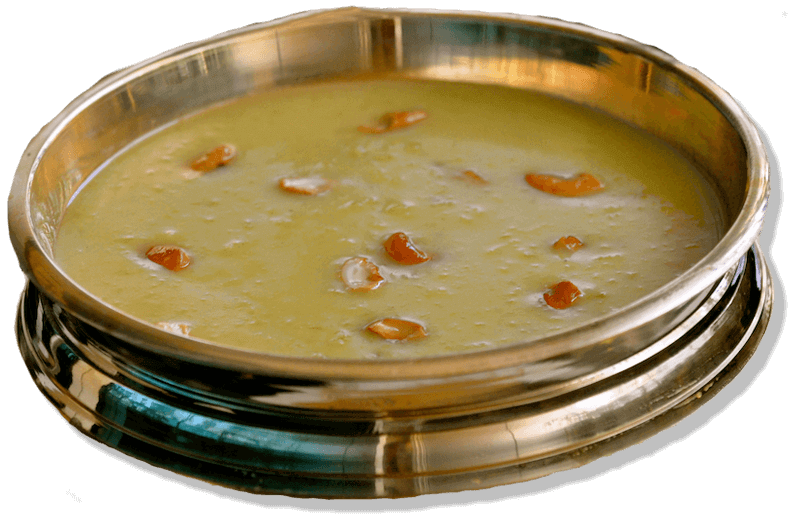
Ada Pradhaman Recipe (Poridge or Payasam or Kheer)
Ingredients:
Maida (1tb sp),Molasses(1/2kg),Coconut oil(1tbsp),
Water(1/2 litr.),Coconut(3 nos),
Cardamom powder(1/2 tbsp),Cashewnuts(50 gms),
Kismis(50 gms),Ghee (2 tb sp).
Preparation Method:
In order to make the 'ada' Mix ingredients 1 to 4 in water to enable to get thick paste. Pour the thick paste on plantain leaves and fold the leaves. Bundle four to five folds and boil it for 10 minutes.Keep the bundle in cold water. Open the fold and drop 'ada' in clean water. Filter the 'ada'. Dilute the Molasses [ Sarkkara] in water and boil the 'ada' in' sarkkarapani' . Prepare the first and second Coconut milk. Add second coconut milk and boil it. Add first coconut milk and cardamom powder and boil it again. Fry the cashew nut and kismas in ghee and add to " Ada Pradhaman".
⚋⚋⚙⚋⚋ Legends of Rakshabandhan ⚋⚋⚙⚋⚋
Legend 1
Shravan purnima's second festival is Raksha Bandhan. This is an ancient tradition. With the passage of time festivals are undergoing changes. Raksha Bandhan is also known as Rakhi. Rakhi has become a sacred festival for sisters and brothers. Sisters tie 'rakhis' to brothers. Priests tie them to people of his congregation. During the middle ages, if a woman tied a Rakhi on the hand of any man, then it became imperative for him, as his religious duty of the highest order, to protect that woman. That man would put his life at stake to protect the honour of that woman.
According to ancient traditions, it is customary to have protection threads that are charged with sacred verses (Mantras) and sanctified with rice, durva grass etc.; to have these tied by people who know the Vedas or by near and dear ones. This protection thread protects one from sins on the one hand and shields against diseases on the other hand. By tying this thread, protection is accorded for a full year and all kinds of fears are removed.
Legend 2
Ages ago, once when Lord Krishna hurt his hand and it started bleeding, Draupadi, Pandava's wife, instead of using a ‘band aid' tore a piece of her sari and tied it on the wound. Lord Krishna was pleased with this and instantly made her his sister. He promised to protect Draupadi if ever she got into trouble and care for her.
Legend 3
Once, Indra, the King of Devataas, dieties, was confronted by the demon king - the Daitya-raaja - in a long-drawn battle. At one stage, the Daitya-raaja got better of Indra and drove him into wilderness. Indra, humbled and crest-fallen, sought the advice of Brihaspati, the Guru of Gods. The Guru told him to bide his time, prepare himself and then march against his adversary. He also indicated that the auspicious moment for sallying forth was the Shraavana Poornima. On that day, Shachee Devi, the wife of Indra, and Brihaspati tied Raakhis around Indra's right-wrist. Indra then advanced against the Daitya-raaja, vanquished him and re-established his sovereignity.
Impact of Rakshabandhan on Indian History
The strong bond represented by Rakhi has resulted in innumerable political ties among kingdoms and princely states. The pages of Indian history testify that the Rajput and Maratha queens have sent Rakhis even to Mughal kings who, despite their differences, have assuaged their Rakhi-sisters by offering help and protection at critical moments and honoured the fraternal bond. Even matrimonial alliances have been established between kingdoms through the exchange of Rakhis.
History has it that the great Hindu King Porus refrained from striking Alexander the Great because the latter's wife had approached this mighty adversary and tied a Rakhi on his hand, prior to the battle, urging him not to harm her husband.
⚋⚋⚙⚋⚋ Preparing for Rakshabandhan ⚋⚋⚙⚋⚋
Prepare your Thali
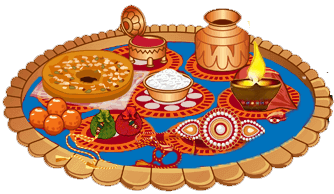
Place the diya (a small lamp to do aarti of your brother) in the thali.
On one side of the diya place kumkum and rice. On the other place the rakhi.
Keep some Sweets along side.
Decorate the thali as you wish and make it look as colourful as possible.
Create your own Rakhi
Here is an idea of how to make your very own rakhi.
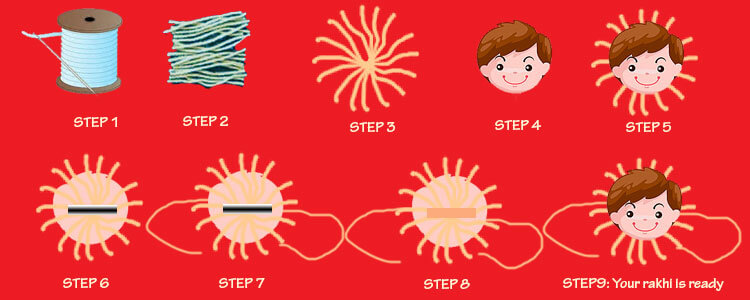
Explanation to the steps above:
Step 1. Get a spool of thread.
Step 2. Cut them into equal lengths.
Step 3. String them together to create this kind of image ☞❋
Step 4. Take your Brother’s picture(a very small one) and cut it nicely
Step 5. Place the picture on the rakhi
Step 6. Take a straw and stick it horizontally
behind the picture
Step 7. Now take the piece of thread
and pass it through the straw
Step 8. Cover the straw with thread
Step 9. Now your Rakhi is ready.
You can decorate your rakhi with soft silky threads of various colours, and also with ornaments, pictures, gold and silver threads etc.
Voila! There you have a special Rakhi for your special brother!
⚋⚋⚙⚋⚋ Tying a Rakhi⚋⚋⚙⚋⚋
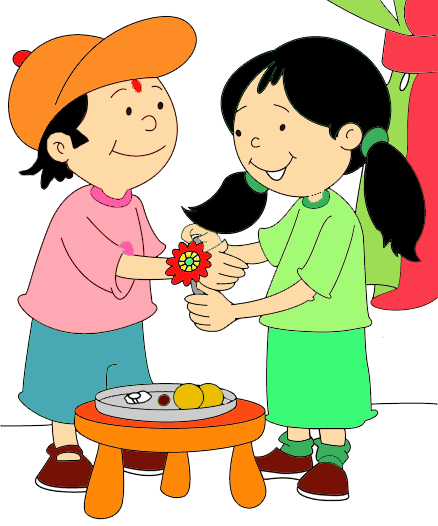
Sisters, before you begin, would you not like to know the legend behind this tradition? You can then ask your brothers to gift you as Lord Krishna gifted Draupadi on this traditional day!
All set? Let's get going! Invite your brother to come and sit next to you. Offer “aarti” (a traditional way of worshipping) to your brother with the thali you just prepared. Then tie the special pompom Rakhi thread on his right wrist. Apply 'tilak' or vermilion powder to your brother’s forehead.
You can also recite this verse like they do in the northern parts of India:
Yena baddho Balee raajaa daanavendro mahaabalah |
tena twaam anubadhnaami rakshe maa chala maa chala ||
Translation of the above verse is as follows :
"I am tying a Rakshaa to you, similar to the one tied to Bali the powerful king of demons. Oh Rakshaa, be firm, do not waver."
Now Brothers, it is now your turn!
Bless your sisters and gift them with the oath of protection and love you have for them. Of course you can do that by buying her gifts and, more important, by keeping your promise to protect her and being there for her all through her life in good times and bad times.
⚋⚋⚙⚋⚋
Rakshabandhan Recipe⚋⚋⚙⚋⚋
Preparing Vermicelli Kheer for your Dearest Brother
Ingredients:
1cup Roasted Vermicelli
1.5 liters Milk
½ tsp. Cardamom Powder
½ tsp. Saffron
Dry fruits and raisins
Method of preparation:
1. Boil the milk in a wide pan.
2. Add the roasted Vermicelli and sugar to taste.
3. Let it boil till it thickens.
4. Dissolve saffron in 1tsp. Water.
5. Add cardamom and saffron to the thick vermicelli and milk mixture.
6. Garnish with soaked almonds and raisins.
7. Decorate in a dish and serve with a smile and love.
♠ Gudi Padwa - The Indian New Year ♠

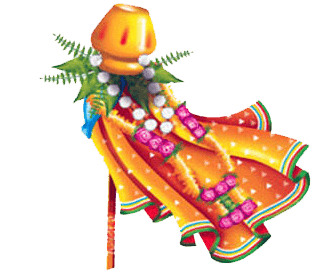 Presently in Bharat (India), New Year is being celebrated on 1st January as per the Western calendar. But according to the Hindu scriptures, the date on which Chaitra Shuddha Pratipada as per the Hindu lunar calendar falls, is considered glorious in all ways - as per the cycle of Nature and historical & spiritual significance. So, to ensure that the beginning of a new year happens on an auspicious note, the people of Maharashtra, India celebrate this day as Gudi Padwa in a traditional way as prescribed in the Hindu scriptures. Several benefits are endowed on the one celebrating this day as a New Year.
Presently in Bharat (India), New Year is being celebrated on 1st January as per the Western calendar. But according to the Hindu scriptures, the date on which Chaitra Shuddha Pratipada as per the Hindu lunar calendar falls, is considered glorious in all ways - as per the cycle of Nature and historical & spiritual significance. So, to ensure that the beginning of a new year happens on an auspicious note, the people of Maharashtra, India celebrate this day as Gudi Padwa in a traditional way as prescribed in the Hindu scriptures. Several benefits are endowed on the one celebrating this day as a New Year.
♠ Significance of Gudi Padwa ♠

Natural:
Towards the first day of the month of Chaitra (padwa), the sun assumes a position above the Vasant intersection (the point of intersection of the equator and the meridians) and the spring season commences. In Shrimad Bhagvad Gita (10.35), The Lord says, ‘Among the seasons, the exhilarating Vasant season (spring) is my manifestation’. In this season, the weather is pleasant and exhilarating. In the Shishir season (autumn) the trees shed their leaves. Towards padwa, trees bear new foliage and appear fresh.
Historical:
Rama slayed Vali on this day. Lord Ramachandra returned to Ayodhya after slaying the evil demons and Ravan on this very day. The Shakas too defeated the Huns on this day. This day also commemorates the commencement of the Shalivahan calendar after Shalivahan vanquished his enemies.
Spiritual:
1. Creation of the universe: Since on this day Lord Brahma created the universe and the Satyayug began, it marks the commencement of the New Year.
2. One among the three and a half auspicious days (‘Muhurts’): Gudipadwa, Akshay trutiya and Dasra (Vijayadashmi) each make up one, and the first day of the Hindu lunar month of Kartik comprises half of the total three and a half auspicious days. The special feature of these three and a half auspicious days is that unlike other days when one has to choose an auspicious moment to perform a ritual, in contrast, on these auspicious days one does not need to, as every moment of these days is auspicious.
3. The higher incidence of prajapati sanyukta (conjoint) frequencies on the earth: The tantra text Ganeshyamal states that in all 108 frequencies, one each from the four parts (charans) of the twenty-seven lunar asterisms from the region of lunar asterisms (nakshtralok / karmadevlok) 27×4=108 reach the earth. They disintegrate further into four types of frequencies - yama, surya, prajapati and sanyukta (conjoint).
On this day, the Tej and Prajapati frequencies are effective in large measures. During sunrise on this day, the Chaitanya (Divine Consciousness) emitted from these frequencies can be retained for a longer period. It is accumulated in the cells of the embodied soul and is used by the embodied soul as and when required. Therefore within 5-10 minutes of sunrise one should perform ritualistic worship of the Gudi.
Science in the worship of the Gudi:
The divine consciousness emanating during sunrise, absorbed at that time lasts longer. Thus the Gudi should be worshipped within 5-10 minutes after sunrise!
On Gudi Padwa, the waves consisting of the fire element (Tej tatva) and the creative element (Prajapati element) are activated on a large scale. The divine consciousness emanating during sunrise, absorbed at that time lasts longer. This consciousness is stored in the body cells and used as required. Hence the Gudi should be worshipped within 5-10 minutes of the sunrise.
♠
Gudi Padwa Celebration ♠

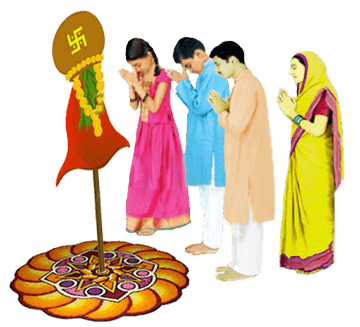
Ablution with oil (abhyangasnan) - an auspicious bath:
On this day one should wake up early in the morning and take an oil bath. With an ordinary bath the raja and tama components decrease by 1/1,00,000 % and the sattva component increases by the same amount for a duration of only three hours. However with an oil bath it lasts for four to five hours. An oil bath consists of an oil massage to facilitate the absorption of oil by the skin followed by a warm water bath. Oil should be applied to retain the elasticity of the skin. Warm water is auspicious and pleasing to the body. Bathing after an oil massage retains only that amount of oiliness that the skin and hair require. Hence an oil massage is necessary before a bath. Application of oil after a bath is inappropriate.
Decorating the doorstep: After a bath one should decorate the lintel of every door with a bunting of mango leaves and red flowers. Red flowers are used because red colour indicates auspiciousness.
Ritualistic worship (puja):
First ritualistic worship of God as a routine ritual is done. ‘One should perform a ‘mahashanti’ on New Year’s day. The shanti begins with the worship of Lord Brahma, as He is responsible for creating the universe on this day. He is offered davna (a kind of fragrant plant) during the worship. Later a sacrificial fire (hom) and offering of oblations through the fire (havan) are performed and offerings to Brahmans are made. Then Lord Viíhnu who manifests Himself in countless forms is worshipped. Obeisance is paid to Him chanting the mantra meaning ‘I bow to Lord Vishnu who manifests in innumerable forms.’ Then the Brahmans are offered money or presents (dakshina) and if possible historical and mythological texts (Purans) are presented to them. It is said, that by performing this ‘shanti’ one is cleansed of all sins, no new sins are generated, the lifespan is increased and one becomes wealthy.’ (1) By performing a sanvatsar worship, all sins are cleansed, the lifespan is prolonged, a woman’s married life is prolonged and one acquires serenity. On this day, the Deity of that day of the week is also worshipped. The following table gives the days of the week and the corresponding presiding Deity of that day.
Monday - Lord Shiva
Tuesday - Parvati ji / Laxmi ji / Lord Ganesha
Wednesday - Lord Pandurang
Thursday - Gurudev Datta
Friday - Parvati ji / Laxmiji
Saturday - Hanuman ji
Sunday - Surya Devata (Sun)
Hoisting the Gudi:
The gudi, which is Brahma’s flag (Brahmadhvaj) is hoisted in every house as a symbolic representation of Rama’s victory and happiness on returning to Ayodhya, after slaying Ravan. Since a symbol of victory is always held high, so is the gudi (flag).A bright green or yellow cloth adorned with brocade (zari) is tied to the tip of a long bamboo over which gaòhi (a type of sweet), neem leaves, a twig of mango leaves and a garland of red flowers is tied. This is then hoisted by placing a silver or copper pot placed in the inverted position over it. Beautiful designs with special powder of soft, white stone (rangolis) are drawn on the floor in front of it. Everyone eagerly waits to usher in the New Year. Then uttering the words, ‘I offer obeisance to the flag of Lord Brahma’ one should ritualistically worship the gudi with a resolve. Since Lord Brahma created the universe on this day, this flag is called ‘the flag of Brahma’ (Brahmadhvaj) in the scriptures. Some also refer to it as ‘the flag of Indra’ (Indradhvaj).
The prajapati frequencies enter the house from the atmosphere using the gudi as a medium. (This operates just like the antenna of a television set). The next day onwards one should use the pot for drinking water as it is charged with the prajapati frequencies and imparts the same kind of impressions to the water in it. Thus one gets the benefit of the prajapati frequencies throughout the year.
An offering (Prasad) of neem:
Since neem has the highest ability to absorb prajapati frequencies, on this day it is partaken of as an offering (Prasad). One should distribute this offering prepared by mixing together tender leaves and flowers of neem, soaked split gram lentil (dal) or soaked gram, honey, cumin seeds and a little of asafoetida amidst chanting of a mantra. Neem is partaken of on Gudipadwa day as it has the maximum ability to absorb the frequency of Prajapati - the Creator while milk, curd, clarified butter (ghee) and sugar are avoided in the month of Chaitra, due to their minimum ability.Ploughing the soil:
On this day one should start ploughing the soil. As a result the soil below is churned up. The subtle soil particles get charged with the prajapati frequencies and its ability to germinate seeds increases manifold. Consecrated rice (akshata) should be sprinkled on the instruments used in farming and on the oxen amidst chanting of the mantra, which generates the prajapati frequencies. Labourers working in the fields should be gifted with new clothes. The meal given to the labourers and oxen on that day should comprise of ripe pumpkin, lentil (mung dal), rice, puran [gram lentil (dal) cooked till soft and ground to a paste with jaggery], etc.Donation:
The needy should be given all kinds of offerings. For example, offering free drinking water by setting up a stall. This appeases the ancestors.Performing actions which bestow happiness: One should spend this day happily, listening to auspicious songs, musical instruments and stories of holy men. One should enjoy the night with one’s wife. Thus the entire year becomes a happy one.
♠
Hoisting the Gudi ♠

Positioning of the Gudi:
Care should be taken to raise the Gudi next to the main entrance of the house. The spot selected should be on the right side (when sighted from the house) of the entrance. The right side symbolizes active state of the soul.
1. The place for raising the Gudi should be cleaned and then a Swastik rangoli should be drawn on the ground. Turmeric and vermilion (Haldi-kumkum) should be offered at the center of the Swastik.
2. While raising the Gudi, the 'Shiva-Shakti' element in the Universe should be invoked. This enables all the constituents of the Gudi to accept divine elements.
3. According to a Scholar, the Gudi symbolizes the 'Sushumna nadi' of our body. Hence, the Gudi should be raised at the entrance. And it should be kept tilted at an angle.
Prayer:
'O Lord Brahma, Lord Vishnu! Please enable me to absorb the elements of creation, fire and Sun present in the atmosphere. Let the Divine consciousness present in these elements be preserved constantly. Let the energy thus received, be used for my spiritual practice.'
Reason for hoisting the Gudi during war:
Gudi is a symbol of victory. Amongst the various qualities of God, 'Being Victorious' is one and it symbolizes that God has achieved victory at the outset and at various levels. To symbolize this at every level of war, a Gudi is hoisted.
On Gudi Padwa, the waves consisting of the fire element (Tej tatva) and the creative element (Prajapati element) are activated on a large scale. The divine consciousness emanating during sunrise, absorbed at that time lasts longer. This consciousness is stored in the body cells and used as required. Hence the Gudi should be worshipped within 5-10 minutes of the sunrise.
♥ Holi Celebration ♥
Holi ! Holi !
The festival of Holi begins on Dwadashi - on the twelfth day of the waxing moon of the month of Phalgun
The literal meaning of 'Holi' is burning.
Social Significance
Holi helps to bring Society together and strengthen the secular fabric of our country as the festival is celebrated by non Hindus also as everyone likes to be part of such a colourful and joyous festival.
Also the tradition of holi is that even enemies turn friends on Holi and forget any feeling of hardship that may be present. Besides on this day people donot differentiate between the rich and the poor and everyone celebrates the festival together with a spirit of bonhomie and brotherhood.
In the evening people visit friends and relatives and exchange gifts, sweets and greetings. This helps in revitalizing relationships and strengthening emotional bonds amongst the people.
Legends of Holi
There are various legends to explain the meaning of this word, most prominent of all is the legend associated with the demon Hiranyakashyap.
Hiranyakashyap wanted everybody in his kingdom to worship only him but to his great dissapointment, his son, Prahalad became an ardent devotee of Lord Narayana. The king's sister Holika, who was supposed to be immune to fire, tricked her nephew Prahalad on sitting on her lap in a bonfire in order to destroy him. But because she was using her powers for evil, the plan failed and Prahalad emerged unharmed from the fire, while Holika was devoured by the flames. The festival, therefore, celebrates the victory of good over evil and also the triumph of devotion.
Another legend of Holi is linked to Lord Krishna. Lord Krishna loved festivity. He frolicked around with his band of cowherds and maidens of the village in his childhood and youth.
The hamlets of Brindavan, Gokul and Barsana were full of fun and festivity. Lord Krishna played Holi with much gusto. He played pranks on the Gopis. They sprayed color on each other with Gulal made up of gay shades of pink, magenta, red, yellow and green along with Abeer (small crystals or paper-like chips of mica). Krishna's favorite 'victim' was his childhood sweetheart Radhika, who lived in Barsana.
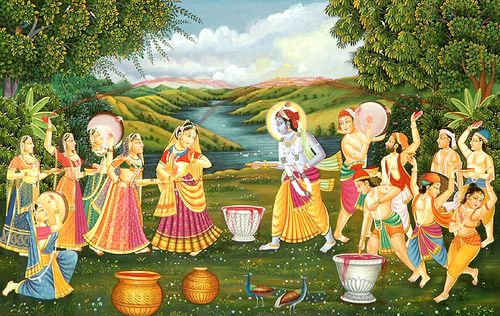
♥ Holi Tips ♥
1). Play safe. Don't get boisterous and don't let others to be rude to you.
2). The best option is to play with natural home made colours. Your skin and hair will feel pampered with the use of skin friendly natural products.
3). If natural colours are not available, ensure that mummy or daddy buys you good quality colours.
4). Use more of red or pink colours, which look good and come off easily. Gaudy purple, green, yellow, orange have more chemicals in them and they could be harmful.
5). Make sure you apply cream well on your face before and after you play holi.
6). Oil your hair well so that the colour doesnt stick to your hair and can be washed off later.
7). Cover your hair with a cloth or hat to protect it from being coloured with hard to rinse dyes.
8). Make sure that any powder or any other product doesnt go inside your eyes. Please ensure that your eyes remain protected always. If by chance colour goes inside, wash immediately with plenty of water.
9). If someone attacks your face with colour, close your mouth and eyes tightly so that colour doesnt go inside.
10). Take a bath later only after you have finished playing the Holi.
11). If you are prone to skin allergies avoid playing with powdered colours and gulal.
12). Avoid running on wet floors, so that you dont slip and injure yourself.
◇ About Makarsankranti ◇
Makara literally means 'Capricorn' and Sankranti is the day when the sun passes from one sign of the zodiac to the next. The Sankranti of any month is considered auspicious as it signifies a fresh start. However Makara Sankranti is celebrated in the month of Magha when the sun passes through the winter solstice, from the Tropic of Cancer to the Tropic of Capricorn. This feast is celebrated on January 14th, and is the only feast of the Indian calendar which is not celebrated on a fixed day of the lunar month. On this day the sun enters the constellation of Makar (Croco-dile) and begins to move towards the north.
This feast is celebrated on January 14th, and is the only feast of the Indian calendar which is not celebrated on a fixed day of the lunar month. On this day the sun enters the constellation of Makar (Croco-dile) and begins to move towards the north.Throughout the year the sun passes through twelve constellations: Mesh (Ram, Aries), Vrishabh (Bull, Taurus), Mithun (Couple, Gemini), Kark (Crab, Cancer), Sima (Lion, Leo), Kanya (Girl, Virgo), Tula (Balance, Libra), Vrishchik (Scorpion,Scorpio), Dhanu (Bow, Saggitarius), Makar (Crocodile, Capricorn), Kumbh (Water jar, Aquarius), Min (Fish, Pisces). When the sun does not cross any constellation then there is an extra month called "Adhik Mas". The crossing of the Makar constellation takes place in the month of Paush.
Spiritual Significance: While the religious practices are more or less observed due to faith in the Sastras and the elders, for the spiritual seeker, the observances hold the key to salvation. All these festivals point out to the intelligent man the need to become introvert.
Sankranti means a turning or a complete revolution. A revolutionary change in life from the materialistic to the spiritual seeking is the true Sankranti. Another meaning of makara is crocodile. The crocodile of samsar is keeping the ordinary man in its grip. To turn away from its clutches to the way to salvation was the ceremony of Driving Away the Devil.
◇ Legend of Makarsankranti ◇
 King Sagara of the Solar dynasty was very illustrious and pious. He completed performance of ninety nine Aswamedha yagyas i.e. horse sacrifices and wished to perform the hundredth one also so that he would replace Indra as the king of the Gods. He had sixty thousand sons all of whom followed the sacrificial horse in its one-year wanderings round the earth. Indra was very jealous and wanted to obstruct the successful performance of the sacrifice, as his own position was threatened. As the horse was wandering, Indra came in an invisible form and stole away the horse. The sons of King Sagara who were closely following the horse were baffled by the sudden disappearance of the horse. They made a hectic search for the horse on earth. When they couldn't find it anywhere they started digging the earth in order to reach Patala, the nether world. Indra took the horse to Patala and tied it to a tree in front of the place where Kapila Maharshi was doing tapas. Sagara's sons dug up the earth and made a passage to Patala and entered it to look for the horse. As soon as they reached the place where Sage Kapila was doing tapas, they found the horse near the tree. They jumped to the conclusion that the sage had committed theft of the horse and rushed, shouting and abusing, at him, with drawn swords. Kapila Maharashi was disturbed by their shouts and opened his eyes in anger. Lo, with one look, the sixty thousand princes were reduced to a mountain of ashes. The sage resumed his tapas.
King Sagara of the Solar dynasty was very illustrious and pious. He completed performance of ninety nine Aswamedha yagyas i.e. horse sacrifices and wished to perform the hundredth one also so that he would replace Indra as the king of the Gods. He had sixty thousand sons all of whom followed the sacrificial horse in its one-year wanderings round the earth. Indra was very jealous and wanted to obstruct the successful performance of the sacrifice, as his own position was threatened. As the horse was wandering, Indra came in an invisible form and stole away the horse. The sons of King Sagara who were closely following the horse were baffled by the sudden disappearance of the horse. They made a hectic search for the horse on earth. When they couldn't find it anywhere they started digging the earth in order to reach Patala, the nether world. Indra took the horse to Patala and tied it to a tree in front of the place where Kapila Maharshi was doing tapas. Sagara's sons dug up the earth and made a passage to Patala and entered it to look for the horse. As soon as they reached the place where Sage Kapila was doing tapas, they found the horse near the tree. They jumped to the conclusion that the sage had committed theft of the horse and rushed, shouting and abusing, at him, with drawn swords. Kapila Maharashi was disturbed by their shouts and opened his eyes in anger. Lo, with one look, the sixty thousand princes were reduced to a mountain of ashes. The sage resumed his tapas.King Sagara impatiently waited for the return of his sons along with the horse, hoping to conclude his hundredth sacrifice. At long last, he came to know through Narada, the fate of his sons because of the mischief played by Indra. He was told that unless the Holy Ganges flowed over the ashes of his sons, their souls would never attain salvation. Poor Sagara was heart broken. He was already old by that time and had no more energy left to do this. He had one grandson, Ansumanta the sole male member of the family who survived. He entrusted the grandson with the duty of bringing the heavenly Ganges to Patala and release the souls of his uncles from perdition.
Ansumanta tried, his son Dileepa tried, but in vain. They too died in sorrow for not having been successful in bringing down the holy Ganges.
But Bhageeratha, the son of Dileepa was more successful. He performed intense tapas for Brahma, for Ganges, and Lord Siva and at last got the heaven-born Ganga onto the matted locks of Lord Siva and from there, one thin stream followed Bhageeratha to Patala and flowed over the ashes of Sagara's sons and uplifted their souls to higher worlds. As per tradition, the Ganges descended from heaven on 14th January. Hence the special sanctity of the day.
◇ Celebration of Makarsankranti ◇
 On this day people eat "Khichadi" made of rice and dal. The Paush month is also known as Dhundhur Mas and people eat "bajari" bread mixed with "til" (Sesamum). On the feast of Sankrant "til" is given great importance, for in this season it is considered to have special nutritive and medicinal qualities. "Til" is a very oil-rich seed. Mixed with jaggery or sugar it becomes a very sticky sweet which people exchange with one another as a sign of friendship.
On this day people eat "Khichadi" made of rice and dal. The Paush month is also known as Dhundhur Mas and people eat "bajari" bread mixed with "til" (Sesamum). On the feast of Sankrant "til" is given great importance, for in this season it is considered to have special nutritive and medicinal qualities. "Til" is a very oil-rich seed. Mixed with jaggery or sugar it becomes a very sticky sweet which people exchange with one another as a sign of friendship. 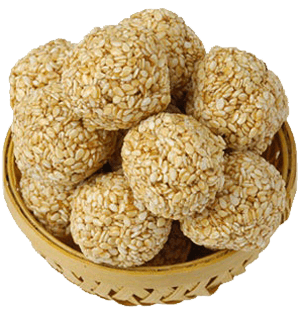 "Tilgul ghya, god bola." ("Take tilgul and speak sweetly") is the phrase on everybody's lips. With this good social custom enimities are forgotten and new friendships started. People are encouraged to emulate the quality of "Tilgul" and stick together in permanent union and love.
"Tilgul ghya, god bola." ("Take tilgul and speak sweetly") is the phrase on everybody's lips. With this good social custom enimities are forgotten and new friendships started. People are encouraged to emulate the quality of "Tilgul" and stick together in permanent union and love.On this day ladies apply "haladi-kumkum" (turmeric powder) on each other's forehead, and children fly kites. Many people bathe at Prayag, near Allahabad, at the meeting point of the Ganges and the Yamuna.
Makara Sankranti is also celebrated throughout India as a harvest festival. It is a way of giving thanks to the elements of nature that help man. This is the period when the winter recedes, paving the way for the summer. It is the time the farmers bring home their harvest. In the coastal regions, it is a harvest festival dedicated to Indra. In Tamil Nadu and Andhra Pradesh, it is celebrated as a three-day harvest festival, Pongal. In Assam, the festival is celebrated as Bhogali Bihu, and in Punjab it is called Lohri.
Throughout the length and breadth of India, 14th January is considered a holy day for sacred baths in places of pilgrimage, rivers and tanks. In fact, bathing is considered mandatory on this day, and according to a popular local belief in the hills of Uttar Pradesh, one who does not bathe on Makara Sankranti is born a donkey in his next birth. The maximum gatherings are to be found at Triveni sangam in Allahabad, at an island near Calcutta and at Brahmasarovara of Kurukshetra. The sacred Ganges is believed to have descended on this day from the heavens, in order to reach Patala. The story connected with it is well known. Apart from Triveni, ritual bathing also takes place at many places like Haridvar and Garh Mukteshwar in Uttar Pradesh, and Patna in Bihar.
A big fair is held at the confluence of the Ganga, the Yamuna and the Sarasvati rivers at Triveni in Allahabad (Uttar Pradesh) on this occasion. Being the month of Magha, this fair is also called Magha Mela.
Since it is also the season to fly kites, the evening sky is a wash with colourful kites of all shapes and sizes.Several kite competitions are held in various localities.

◇ Celebrations of Vaishnavaities ◇
For the Vaishnavaites in South India, the month in which Makara Sankranti occurs is Dhanurmasa, very very sacred as Andal. One of their Alwars played on her heart's strings to please Lord Vishnu and became his spouse in this month. Throughout the month they spend the days singing Tiruppavai, the melodious poems sung by Andal and doing special poojas in the Temples.In Andhra, 14th January is connected with the harvest season and also with the Gopis of Brindavan. For one month before Sankranti, huge patterns of Rangoli are drawn in front of the houses, and young unmarried girls make round balls of fresh cow dung, decorate them with flowers and place them on the Rangoli. In the evenings the balls are made into dry cakes and preserved carefully till the 13th of January. The three days, 13th to 15th are known as Bhogi, Sankranti and Kanumau. On 13th early in the morning a big bonfire is made and all the dry cakes are burnt. In the evening the girls worship the fresh cow dung balls which are called Gobbi, a corruption of Gopi. The unmarried girls pray for suitable husbands, singing and dancing round the balls.
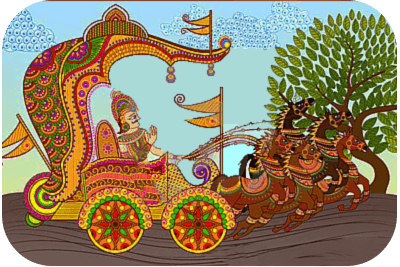 As in the harvest festivals, it is believed that King Bali rises up from Patala on 13th, goes round on 14th and returns to his Patala on the 15th. So on 13th Rangoli is drawn in the form of a chariot leading in one direction and on 15th again the chariots are drawn leading in the opposite direction indicating the return of King Bali. Doll shows are arranged in the houses and the women folk visit one another's houses to see the doll shows. This is to inculcate in the hearts of the people the spirit of sacrifice, Bali, when prosperity comes. They should remember God and also the man in need when there is abundance.
As in the harvest festivals, it is believed that King Bali rises up from Patala on 13th, goes round on 14th and returns to his Patala on the 15th. So on 13th Rangoli is drawn in the form of a chariot leading in one direction and on 15th again the chariots are drawn leading in the opposite direction indicating the return of King Bali. Doll shows are arranged in the houses and the women folk visit one another's houses to see the doll shows. This is to inculcate in the hearts of the people the spirit of sacrifice, Bali, when prosperity comes. They should remember God and also the man in need when there is abundance.
⚜ Gita Jayanti ⚜
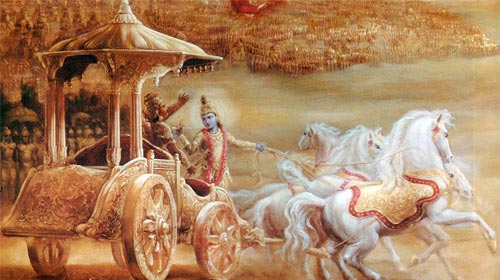 यदा यदा हि धर्मस्य ग्लानिर्भवति भारत ।
यदा यदा हि धर्मस्य ग्लानिर्भवति भारत । अभ्युत्थानमधर्मस्य तदात्मानं सृजाम्यहम्। ।
What is Bhagvad Gita?
Every one of us has heard of days celebrated as Hanuman Jayanti, Buddha Jayanti, etc. Jayanti actually means a birthday of a person. Accordingly, Gita Jayanti is the birthday of the Gita – The Shrimad Bhagavad Gita, a book written by Sage Veda Vyasa. Isn’t it a wonder that we celebrate the birthday of a book! It would be interesting to know about this book The Bhagavad Gita, whose birthday is celebrated across India. The word Gita means a song and Bhagavad means Bhagavan, so it is the Song of the Lord.When did the Lord sing the Gita? And for whom?
Lord Krishna sang it for Arjuna, in the battle field of Kurukshetra. It comprises of 18 chapters (adhyayas) and 700 verses (shlokas). All the teachings of Lord Krishna were subsequently recorded as the Song Celestial or Srimad Bhagavad Gita by Bhagavan Veda Vyasa for the benefit of humanity at large. It is found in the Bhishma Parva of the great epic Mahabharata. The Gita Jayanti (birthdate of the Gita) is celebrated throughout India by the admirers and lovers of this unique book on the 11th day (Ekadashi) of the bright half of the month of Margasirsha according to the Hindu almanac. It was the day on which this scripture was revealed to the world. Bhagavad Gita is a conversation between Lord Krishna and Arjuna. In the battle field of Kurukshetra when the two armies of Kauravas and Pandavas were ready to start the war, Arjuna asked Krishna to drive his chariot right into the middle of the battle field so that he could get a clear view of his enemies. He was anxious to fight, but what he saw was that there were no enemies; instead, an entire gathering of his family and friends including his revered Grandfather Bhishma, his beloved teacher Drona ,Guru of Kuru Lineage Kripacharya, etc. He lost his enthusiasm to fight. He felt a growing weakness in his heart and he showed unwillingness to wage a war against them. He did not want to enjoy the luxuries and glories of a kingdom won over by spilling the blood of his relatives and friends. His mind was shrouded with confusion and dejection. Krishna then sang the Bhagavad Gita and awakened Arjuna to his duties as a warrior and a righteous leader. At the end of the conversation Arjuna’s confusion vanished and clarity dawned on him. It gave him the strength to understand his role and the goal he was pursuing. As we go through the eighteen chapters we can percieve the progressive transformation of Arjuna. Finally, he surrender's to Lord's will saying 'Sthito'smi gata sandehah, karishye vachanam tava', gets ready to wage a war against evil and injustice. Bhagavad Gita is perceived as a magic wand in the hands of the greatest magician of the world, Lord Krishna.Relevance of Gita
If Gita was sung thousands of years back, why should we study it now? We are not fighting any war, correct. Then what is its relevance to us? Yes, we are not physically at war with anyone; but, there is always a war going on in our minds. All of us have two types of personalities in us, the good and the bad. That is to say, at any time we always have a few good qualities or virtues and a few bad qualities or weaknesses. There is a constant struggle going on between the good and the bad qualities. At every moment we are required to make a choice between these to. So we need to learn and understand the Gita so that we make a right choice, the choice of the good over the evil. The Bhagavad Gita was immensely extolled and followed by our freedom fighters Mahatma Gandhi, Bal Gangadhar Tilak, Vinoba Bhave, etc. They have all written commentaries on it. In fact Gandhiji has said “When doubts haunt me, when disappointments stare me in the face, and I see not one ray of hope on the horizon, I turn to Bhagavad-Gita and find a verse to comfort me; and I immediately begin to smile” J. Robert Oppenheimer, Albert Einstien and many scientist all over the world have also been influenced by it. Dr. APJ Abdul Kalam used to read Bhagavad Gita and recite the shlokas. In fact, Bhagavad Gita has been translated in more than 59 languages including many Indian and foreign languages, more than any other book in the world, except The Bible. So let us resolve to learn and understand this song of the Lord. To buy the Bhagavad Gita Chanting cd, visit the website eshop.chinmayamission.com or click on this link.☸ Buddha's Teachings ☸
 Whenever you think about Buddha, what comes to your mind? A great sage sitting under a Bodhi tree in deep meditation, and perhaps even a halo around his head. And you must think – Boring, right?
Whenever you think about Buddha, what comes to your mind? A great sage sitting under a Bodhi tree in deep meditation, and perhaps even a halo around his head. And you must think – Boring, right?But not so. Buddha was a deeply contemplative person. And you know, only when you sit silently and contemplate, you get genious ideas and clear understanding. Doesn't it happen to you also, when you have to do some drawing on a difficult topic given by the teacher or you have to write a story on a topic you dont know much about. So let us see what Buddha has to tell us after his long years of meditation and contemplation.
" My first and foremost teachings are the Four Noble Truths:
The four noble truths
The first truth is that suffering is common to every man. It may come in any form.
The second truth is that suffering could be because of too many selfish desires.
The third truth is that the only solution to that kind of suffering is to limit your desires, to be satisfied with what you already have and make the best of what you have already in your hands.
The fourth truth is the main one. It leads to an eight-pointed path to overcome suffering fully. I have named it the Ashtangamarg, or the Noble Eight-fold Path.
The five precepts
Before we practice the eight fold path, which are my final teachings for all, you should practice the following five precepts:
1. Right Effort: We must always take efforts to help others and improve ourselves – in mind and body.
2. Right Mindfulness: We must always be alert and aware of the right aspect of what things really are. We must not be ignorant and dull
3. Right Concentration: We must always be aware of reality, and not indulge in any craving for things that are worldly and unimportant.
4. Right Understanding: We must understand everything as it is in reality, not as what it outwardly appears to be.
5. Right Thought: We must think sensibly and practically.
Ashtanga Marga (Noble Eight-fold Path)
Now, you are ready to follow 'The Noble Eight Fold Path' given as under:
1. Samma-Ditthi (translated as right view or understanding) Having a right understanding of what is the true thing and not just our beliefs and slowly using this understanding to transform ourselves into a better person.
2. Samma-Sankappa (translated as right thought or attitude)- Giving up hatred and anger and acting from love and compassion. An informed heart and feeling mind that are free to practice letting go everything.
3. Samma-Vaca (translated as right speech) - Clear, truthful, uplifting communication with everyone without any intention to cause harm to anyone.
4. Samma-Kammanta(translated as right action) - A way of life where there is non-injury and non-exploitation of ones' own self and others.
5. Samma-Ajiva (translated as right livelihood) - Earning money and comforts by ethical means without involving in theft, lies, injury, etc to others. This is the basis of an Ideal society.
6. Samma-Vayama (translated as complete effort)-consciously directing our energy to the transformative path of creative, constructive and kind actions.
7. Samma-Sati (translated complete awareness) - Being completely involved in your actions, feelings, people whom you interact with, work, studies, etc. with full involvement.(i.e. applying your attention of both body and mind in whatever you do).
8. Samma-Samadhi (translated as concentration , meditation, absorption)Samadhi is when the mind is fixed on a single object whether studies, work or God or your own self.
These constitutes the Noble Eight-fold path to salvation, which I and my disciples followed.
With what I learnt through enlightenment, I went around sharing my knowledge to one and all. And I soon gained many followers, including my father, family and my son – Rahula, whom I had abandoned in childhood, my father’s friend, King Bimbisara, and my favourite disciple and cousin – Ananda.
I taught them all that I had learnt - that the path to salvation does not lie in excess pleasure, or in extreme poverty and praying day and night to God. You should follow the middle path, where there is neither excessive pleasure nor excessive torture to yourself. A life with basic necessities and limited desires is what makes suffering end, and it keeps you most happy and leads you to Nirvana.
And so I went on my way, teaching others all through my life, until I reached 80. It so happened that I ate a certain dish offered to me by a blacksmith disciple of mine. It was called Sukaramaddhava. I already had a sensitive stomach, and eating this dish made me worse. I could not be cured – I was far away from a doctor. I was taken to Kusinara, where I bathed in a river. My disciples made a hammock for me. And I lay there, my head resting on my hand. Within 18 hours I left the body, and reached Nirvana.
My followers did not choose a leader – I had told them to follow their own paths.
My teachings would be their Master. They went on their way, teaching Buddhism to all."
☸ Bodhifacts ☸
1.) The name “Siddhartha” means “wish fulfilled” or “one who has accomplished his goal”.
2.) Buddha was born in the year 563 BC and died in 483 BC and attained enlightenment at the age of 35.
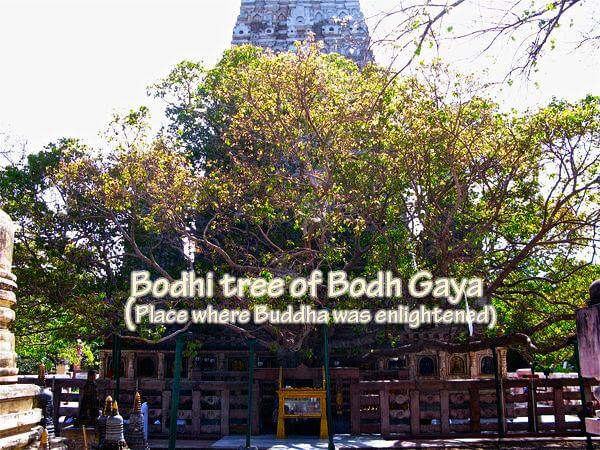 3.) Buddha’s birth, enlightenment, death all occurred on the same day. Also, his wife Yashodhara, charioteer Channa, horse Kantaka, first disciple Ananda and also the Bodhi tree where he meditated were born on the same day.
3.) Buddha’s birth, enlightenment, death all occurred on the same day. Also, his wife Yashodhara, charioteer Channa, horse Kantaka, first disciple Ananda and also the Bodhi tree where he meditated were born on the same day.4.) Buddha is said to be the ninth avatar of Lord Vishnu.
5.) The ascetic who predicted that Siddhartha would be great was a person named “Asita”.
6.) The Noble Eightfold Path is also called the “Middle Way” because it does not follow an extreme path of starvation or the extreme path of luxurious livelihood, but a path that leads between these two extremes.
7.) The blacksmith who gave Buddha the “Sukaramaddhava” dish was named Cundo.
8.) Buddha’s last disciple’s name was Subhadda and Buddha preached to him while on his death-bed.
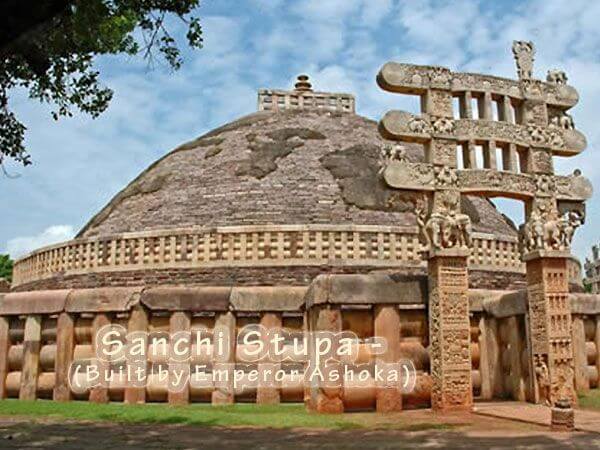 9.) Studies say that Buddha died of an ailment known as “mesenteric infarction”.
9.) Studies say that Buddha died of an ailment known as “mesenteric infarction”.10.) The famous sermon where he taught the concept of the “Middle Way” was held at Deer Park in Sarnath.
11.) Emperor Ashoka built a Stupa at Sanchi in memory of Buddha. Stupas are curved domes in which relics of Buddha are placed in a chamber within. The architecture and sculpting of stupas are noteworthy.
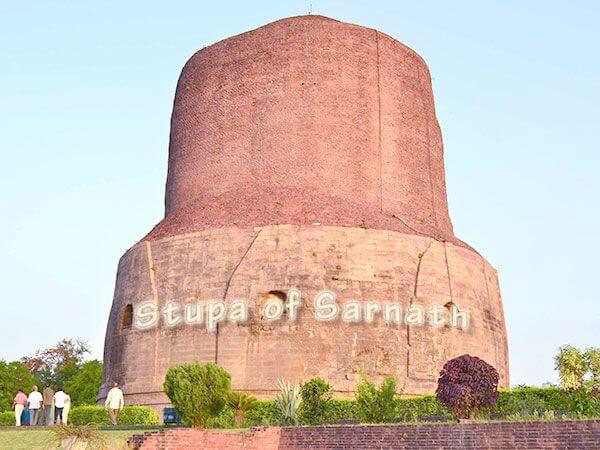 12.) The Mauryan Emperor Ashoka advocated Buddhism in the 3rd century BC.
12.) The Mauryan Emperor Ashoka advocated Buddhism in the 3rd century BC.13.) Sarnath and Bodhgaya are two important places for Buddhists.
14.) Bodhi tree means “the tree of awakening”, more commonly known as the “papal tree”.
 Freedom Freedom Freedom!!
Freedom Freedom Freedom!!In the world of free India every one had absolute freedom to do what they wanted, how they wanted, where they wanted. The people could sing and dance and had the freedom to say anything. They were free and happy people. Then one day, the British from the other side of the world came to visit the free Indian world, which was very rich too. They loved what they saw and decided to stay on in this free India.
Free Indian people did not mind having guests over. First there were few guests, then more came over to share the hospitality. The Indians readily shared their things, took them around, showed them places, made them a part of their own world.
The Indians played by themselves. The British asked the permission to take part in the games. They were allowed to be part of the games. They played by Indian rules. Then slowly and steadily, the British started bullying and dictating their rules. First a few, then many and a day came when the Indians had to play by the British rules.
Now the British made rules for the Indians in their own homes.
1. The Indians were not allowed to play their games on their own.
2. They were also not allowed to play with the British.
3. The Indians were not allowed to travel by first class or sit before the British in the same compartment.
4. Were not allowed to attend the same schools that the British went to.
5. Not allowed in the restaurants owned by British.
6. The Indians were not allowed to say what they wanted, do what they wanted or go any where without the British permission in their own country.
In their own free Indian world the British went around freely but Indians lost their freedom of speech, thought, deed and play. They became slaves to the British rule. The Indians became a very sad lot.
Then one day, the Indians decided enough is enough. We are not going to be sad any more. We want our free India back. We want to be able to do what we like, play as we like. Indians started holding secret meetings. Started planning ways to throw the British out of India.
People like Sardar Patel, Lokmanya Tilak and many more worked with Mahatma Gandhi and dedicated their lives to the ideals of truth, non violence, love and freedom. Tilak fought for the cause and said "Swaraj (freedom) is my birth right".
With all the efforts of these great people one day the British had to leave for their own homes giving Indians their freedom back. This one day was the 15th August 1947 and now once again the Indians were able to hoist their own tri colour flag on the Red Fort in Delhi.
Just imagine not being able to say, to do what we wished, or go where we liked. How bad would life become! Thanks to all those who love freedom and fought for us. we are now free in our own country once again!. Are they not great? Let us know more about them.
☸ The National Anthem ☸
 The Constituent Assembly of India adopted the Indian national anthem from a song written and composed by the Nobel laureate Rabindranath Tagore on January 24, 1950.
The Constituent Assembly of India adopted the Indian national anthem from a song written and composed by the Nobel laureate Rabindranath Tagore on January 24, 1950.Before this, Vande Mataram written by Bankim Chandra Chattapadhya was the National Anthem of India.
Later Constituent Assembly of India,( Vol.XII, 24-1-1950) opined: "The composition consisting of words and music known as Janaganamana is the National Anthem of India, subject to such alterations as the Government may authorise as occasion arises, ..."
Only the first of the five stanzas was designated as the anthem. The anthem goes:
'Jana Gana Mana Adhinayaka Jayehe
Bharata bhagya vidhata;
Punjaba Sindhu Gujarata Maratha,
Dravida Utkala Bangal,
Vindhya, Himachala, Jamuna, Ganga,
Ucchhala Jaladhitaranga;
Taba Shubha Naame Jaage
Taba Shubha Ashish Maage
Gaye taba jaya gaatha.
Jaana Gaana Maana Adhinayaka Jayahe
Bharata bhagya vidhata;
Jaya he Jaye he
Jaya Jaya Jaya Jaya he.'
The English rendition of the song goes like this:
Thou art the ruler of the minds of all people,
Dispenser of India's destiny.
Thy name rouses the hearts of the Punjab,
Sindhu, Gujarat, and Maratha,
Of the Dravid, and Orissa and Bengal.
It echoes in the hills of Vindhyas and
Himalayas, mingles in the music of the
Jamuna and the Ganges and is chanted by
the waves of the Indian sea.
The pray for the blessings,
and sing by the praise,
The saving of all people
waits in thy hand.
Thou dispenser of India's destiny,
Victory, victory, victory to thee.
❦ Symbols of India ❦


National Animal
The magnificent tiger, Panthera tigris (Linnaeus), is a striped animal. It has a thick yellow coat of fur with dark stripes. The combination of grace, strength, agility and enormous power has earned the tiger its pride of place as the national animal of India. Out of eight races of the species known, the Indian race, the Royal Bengal Tiger, is found throughout the country except in the north-western region and also in the neighbouring countries of Nepal, Bhutan and Bangladesh. To check the dwindling population of tigers in India ‘Project Tiger' was launched in April 1973. So far, 25 tiger reserves have been established in the country under this project, covering an area of 33,875 sq km.
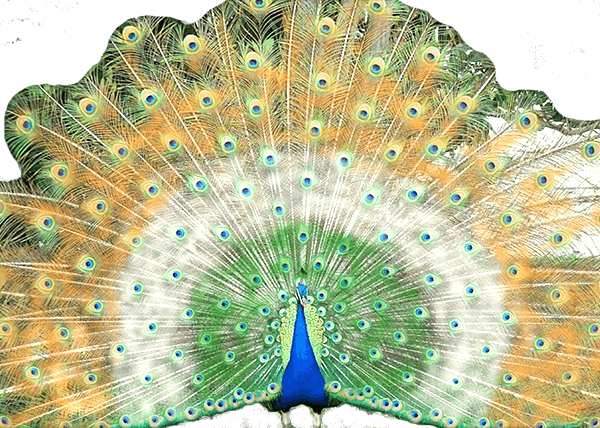
National Bird
The Indian peacock, Pavo cristatus (Linnaeus), the national bird of India, is a colourful, swan-sized bird, with a fan-shaped crest of feathers, a white patch under the eye and a long, slender neck. The male of the species is more colourful than the female, with a glistening blue breast and neck and a spectacular bronze-green train of around 200 elongated feathers. The female is brownish, slightly smaller than the male, and lacks the train. The elaborate courtship dance of the male, fanning out the tail and preening its feathers, is a gorgeous sight. The peacock is widely found in the Indian sub-continent from the south and east of the Indus river, Jammu and Kashmir, east Assam, south Mizoram and the whole of the Indian peninsula. The Peacock enjoys protection from the people as it is never molested for religious and sentimental reasons. It is fully protected under the Indian Wildlife (Protection) Act, 1972.

National Flower
Lotus (Nelumbo nucifera) is the National Flower of India. It is a sacred flower and occupies a unique position in the art and mythology of ancient India and has been an auspicious symbol of Indian culture since time immemorial.
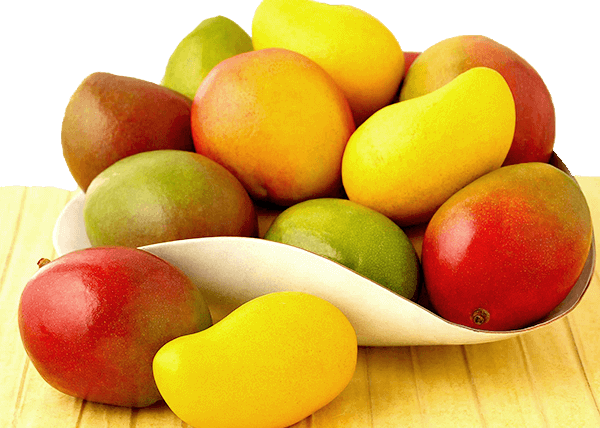
National Fruit
The Mango is the national fruit of India. A favourite of most Indians, this fruit has been cultivated in the country since ancient times. There are over loo types of mangoes in India, of various colors, sizes, and shapes. Common in the tropical part of the world, mangoes are liked hugely and relished for their sweet juice and bright colors. Rich in vitamin A, C, and D, mangoes are also useful for health. Indians eat mangoes ripe, or prepare them green as pickles or chutneys (condiments). The poet Kalidasa sang its praises in his immortal works. Akbar planted 100,000 mango trees in Darbhanga, known as Lakhibagh. Even well known visitors to India, like Alexander and HieunTsang, were generous in their appreciation for Indian mangoes.
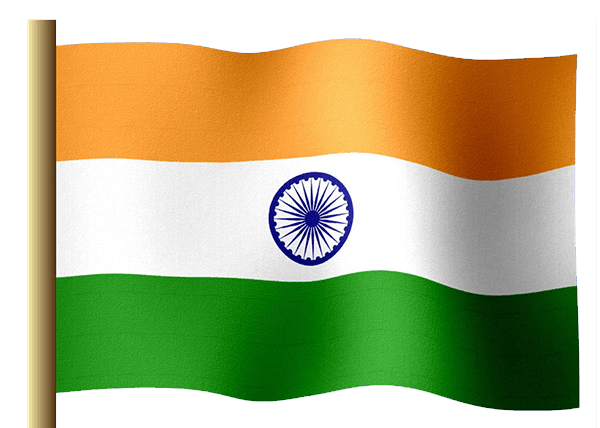
National Flag
The National flag is a horizontal tricolour of deep saffron (kesari) at the top, white in the middle and dark green at the bottom in equal proportion.The ratio of width of the flag to its length is two to three. In the centre of the white band is a navy blue wheel which represents the chakra. Its design is that of the wheel which appears on the abacus of the Sarnath Lion Capital of Ashoka. Its diameter approximates to the width of the white band and it has 24 spokes. The design of the national flag was adopted by the Constituent Assembly of India on 22 July 1947. Its use and display are regulated by the Indian Flag Code.

National Emblem
The State emblem is an adaptation from the Sarnath Lion Capital of Ashoka. In the original, there are four lions, standing back to back, mounted on an abacus with a frieze carrying sculptures in high relief of an elephant, a galloping horse, a bull and a lion separated by intervening wheels over a bell-shaped lotus. Carved out of a single block of polished sandstone, the capital is crowned by the Wheel of the Law (Dharma Chakra). In the State emblem, adopted by the Government of India on 26 January 1950,only three lions are visible, the fourth being hidden from view. The wheel appears in relief in the centre of the abacus with a bull on right and a horse on left and the outlines of other wheels on extreme right and left. The bell-shaped lotus has been omitted. The words Satyameva Jayate from Mundaka Upanishad, meaning ‘Truth Alone Triumphs’, are inscribed below the abacus in Devanagari script.
⚑ Republic Day ⚑
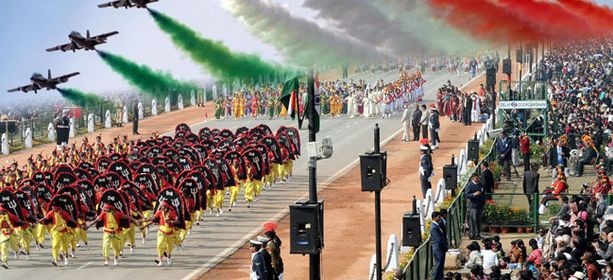
Republic Day honors the date on which the Constitution of India came into force on 26 January 1950 replacing the Government of India Act (1935) as the governing document of India.
The Constitution was adopted by the India Constituent Assembly on 26 November 1949, and came into effect on 26 January 1950 with a democratic government system, completing the country's transition toward becoming an independent republic.
26 January was selected for this purpose because it was this day in 1930 when the Declaration of Indian Independence (Purna Swaraj) was proclaimed by the Indian National Congress.
History:
India achieved independence from British rule on 15 August 1947 by peaceful nonviolent struggle led by Mahatma Gandhi. The independence came through a law known as the Indian Independence Act 1947. This Act partitioned British India into the two new independent Commonwealth of Nations: India and Pakistan.India obtained its independence on 15 August 1947 as a constitutional monarchy with George VI as head of state and the Earl Mountbatten as governor-general. The country, then did not yet have a permanent constitution. Hence, all its laws were based on the modified law used by British India known as Government of India Act.
On 28 August 1947, the Drafting Committee was appointed to draft a permanent constitution, with Dr B R Ambedkar as chairman. A draft constitution was prepared by the committee and submitted to the Assembly on 4 November 1947.
After multiple reviews and some modifications, the 308 members of the India Constiuent Assembly signed two hand-written copies of the document (one each in Hindi and English) on 24 January 1950. Two days later, it came into effect throughout the nation.
While India's Independence Day celebrates its freedom from British Rule, the Republic Day celebrates of coming into force of its constitution.
Celebration:
The main Republic Day celebration is held in the national capital, New Delhi, at the Rajpath before the President of India. On this day, ceremonious parades take place at the Rajpath, which are performed as a tribute to India.Delhi Republic Day parade is held in the capital, New Delhi, from the Raisina Hill near the Rashtrapati Bhavan (the President's residence), along the Rajpath, past India Gate.Prior to its commencement, the Prime Minister lays a floral wreath at the Amar Jawan Jyoti, a memorial to martyred soldiers at the India Gate at one end of Rajpath, which is followed by two minutes silence in the memory of them. It is a solemn reminder of the sacrifice of the martyrs who died for the country in the freedom movement and the succeeding wars for the defence of sovereignty of their country. Thereafter he/she reaches the main dais at Rajpath to join other dignitaries, subsequently the President arrives along with the chief guest of the occasion.
Parades and celebrations are held at various schools across India and sweets are distributed at the end of the function for all the visitors.
